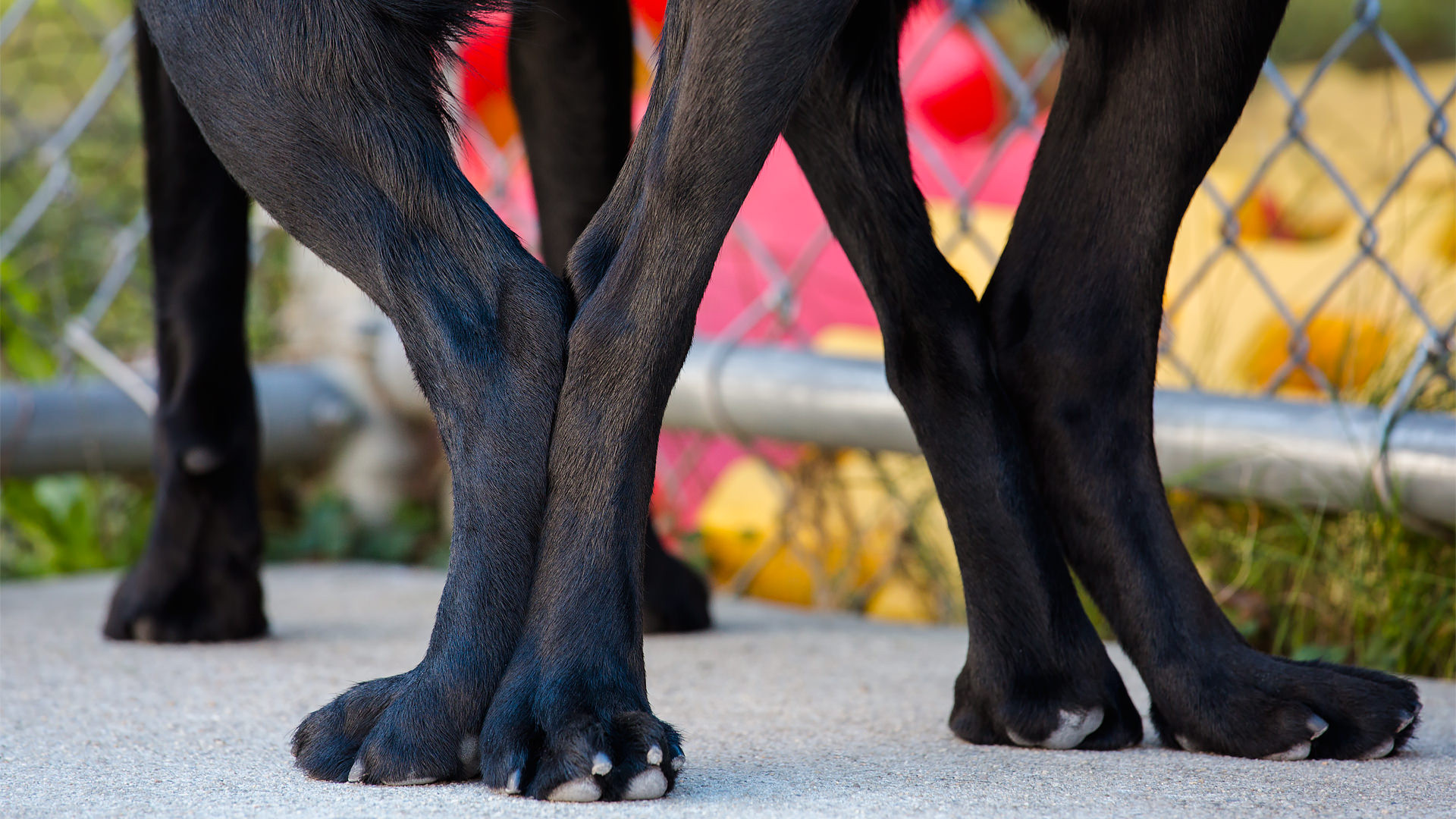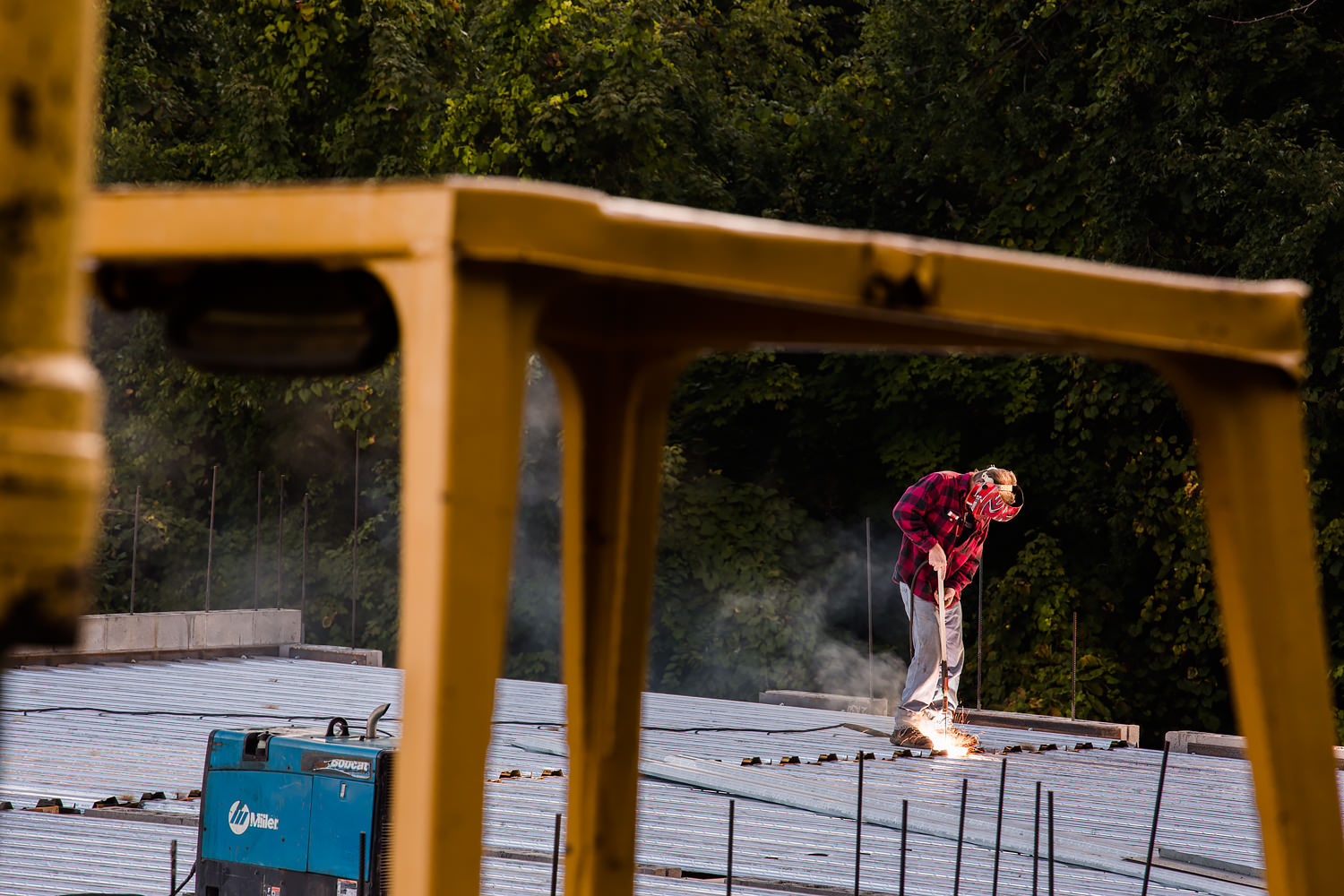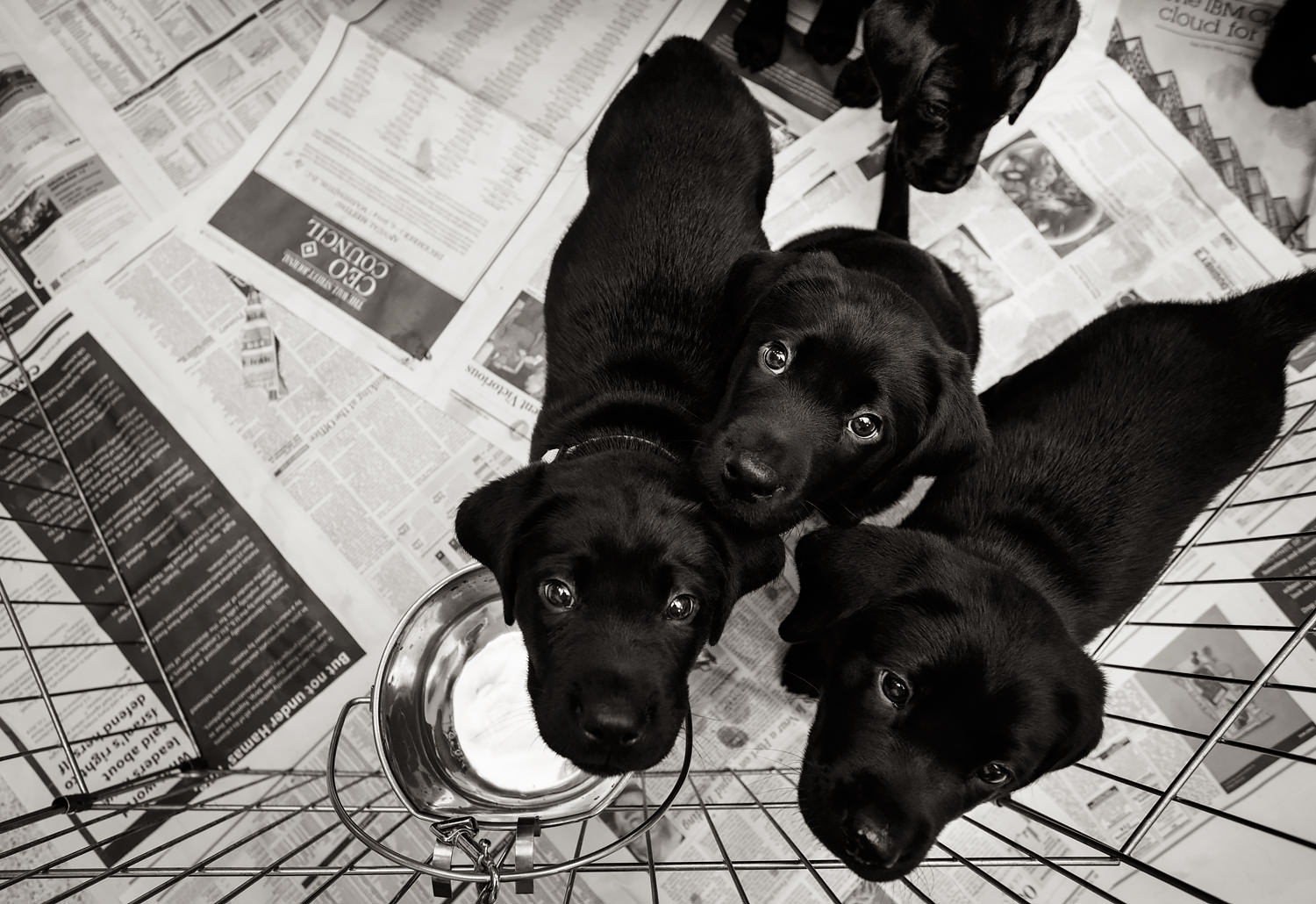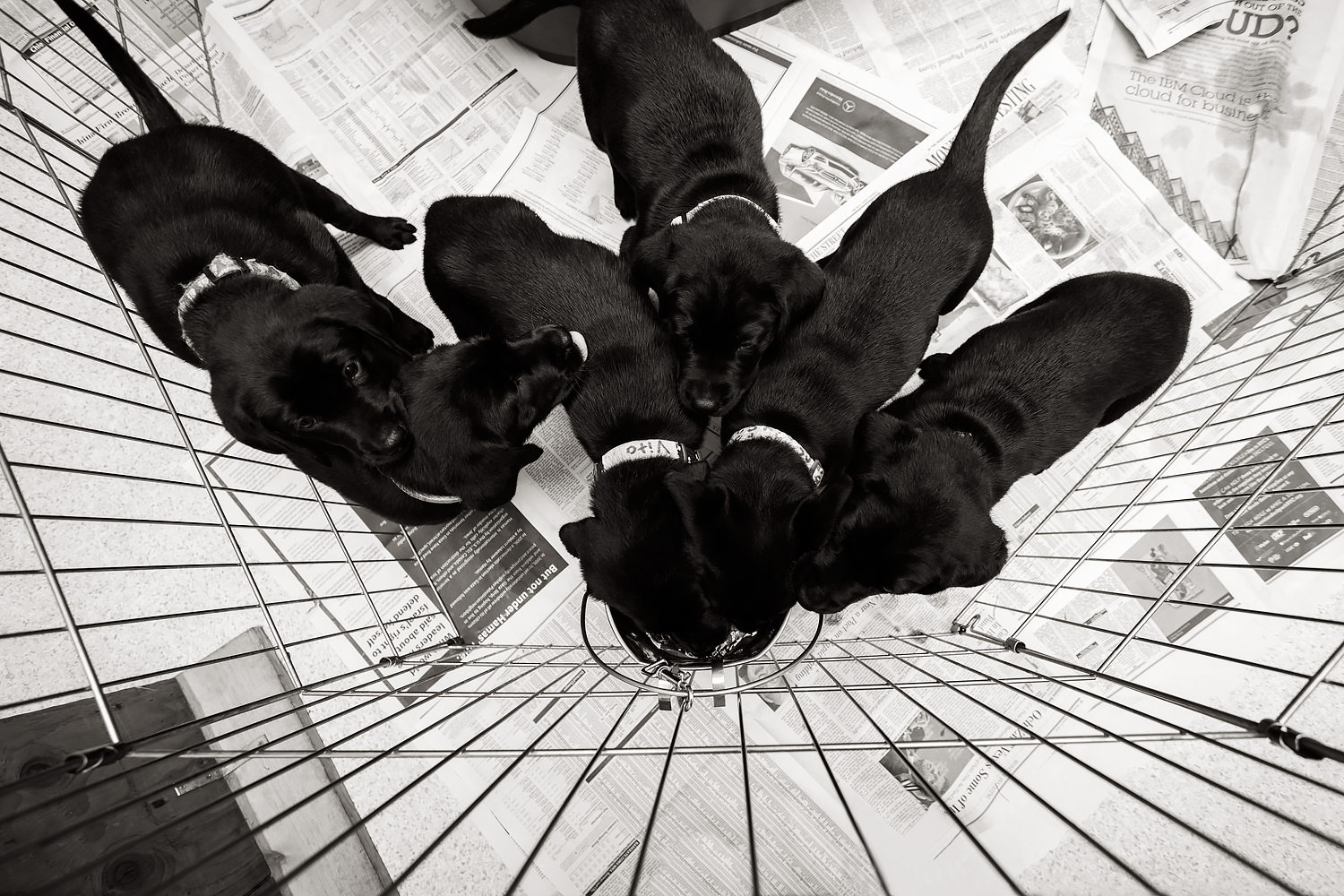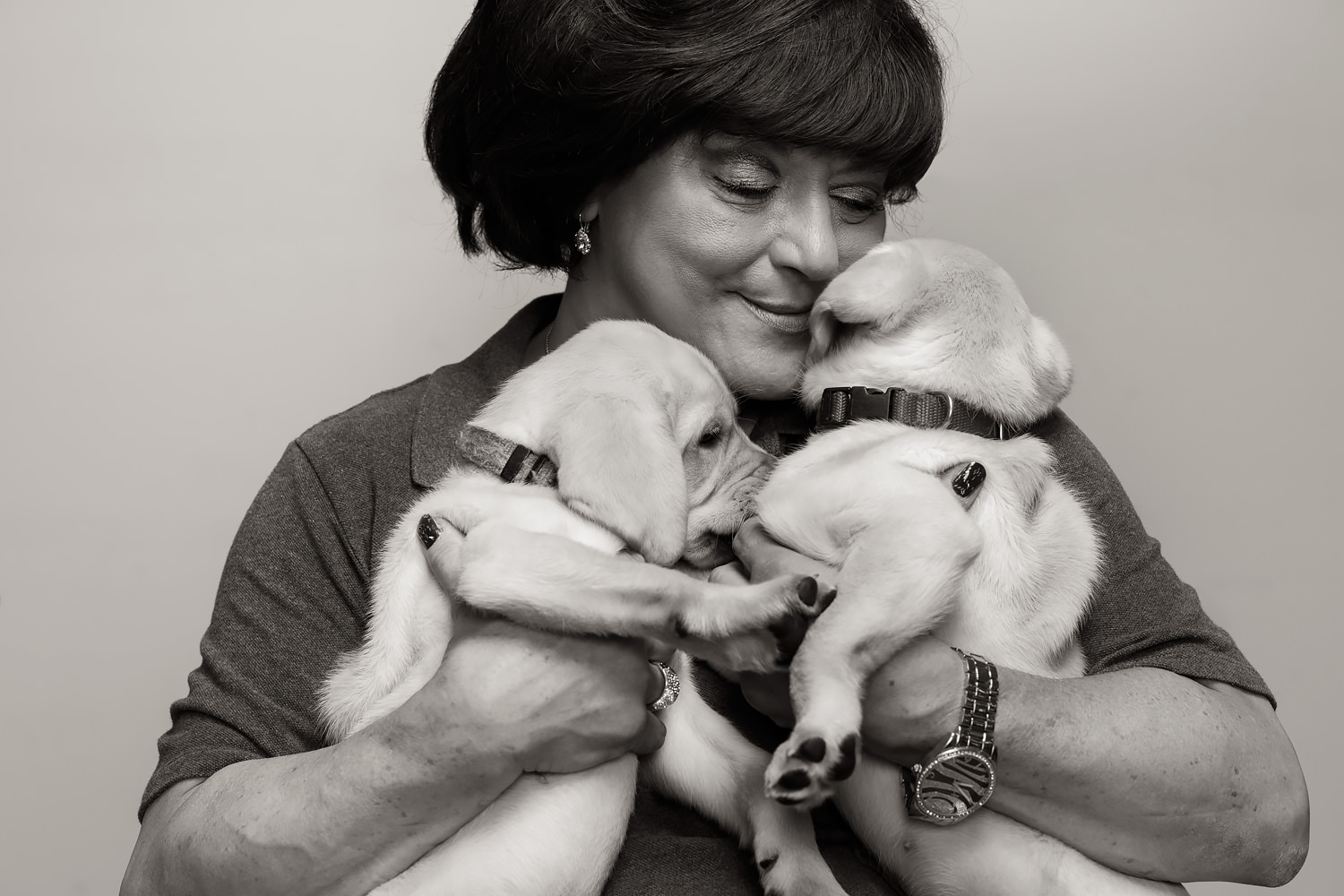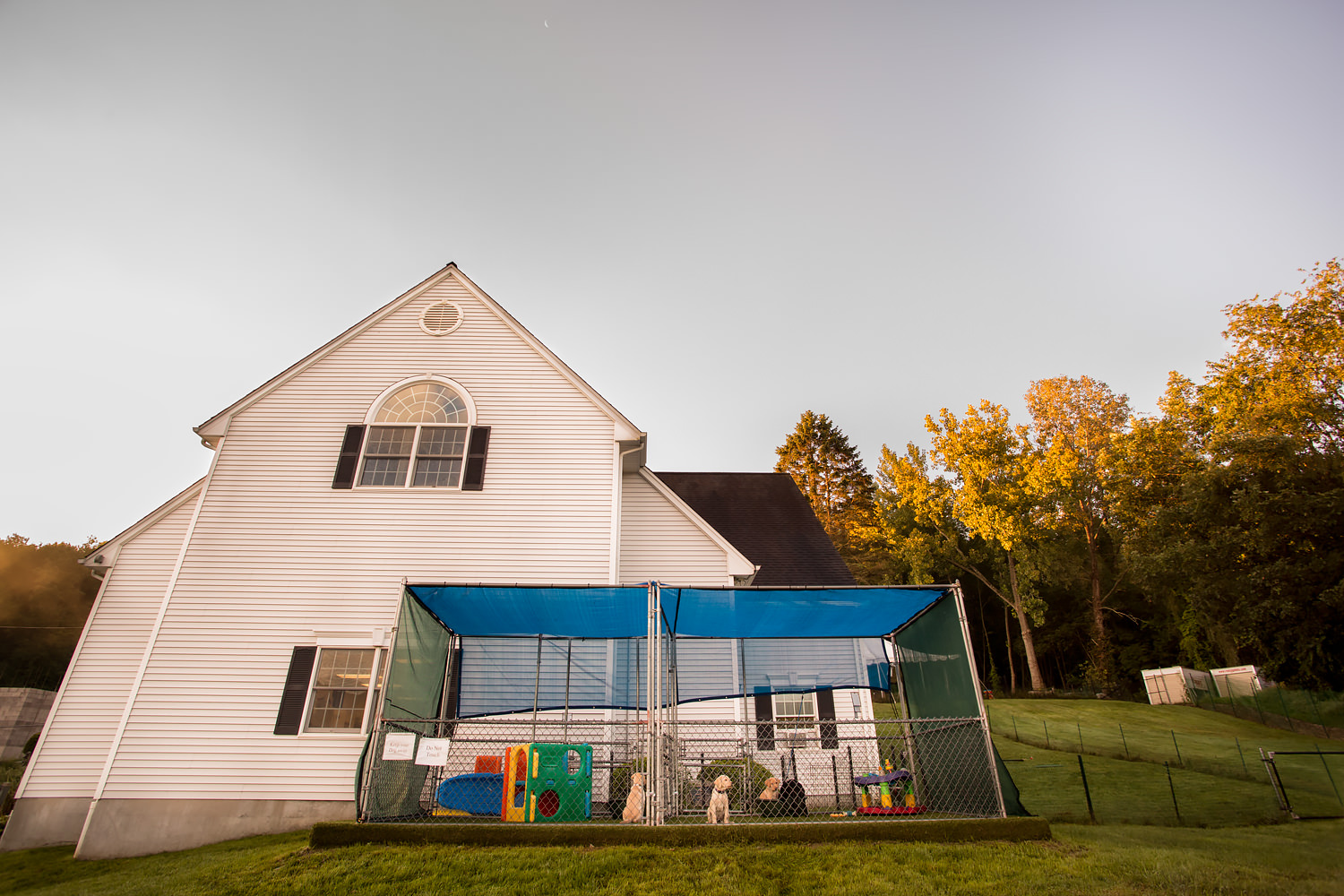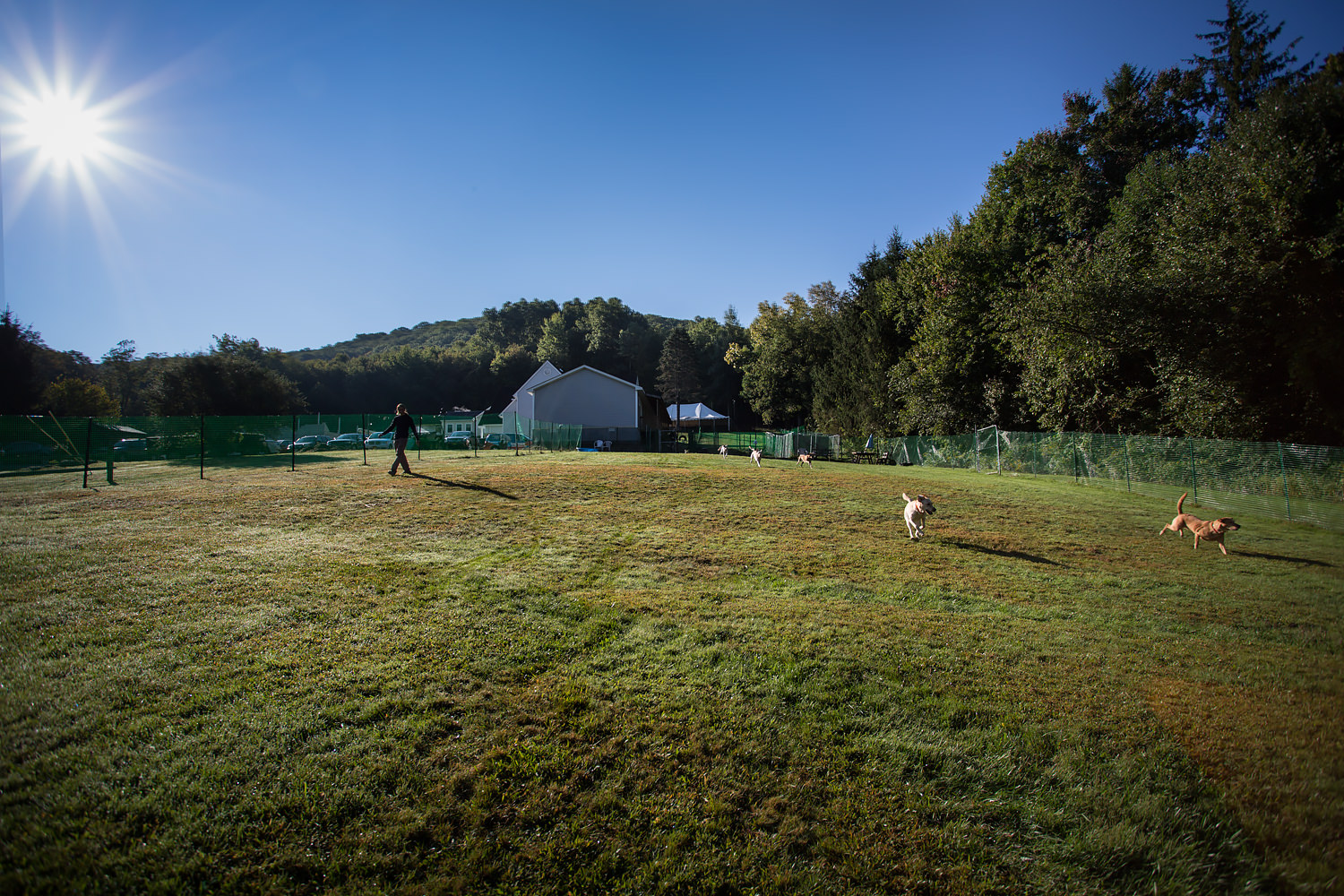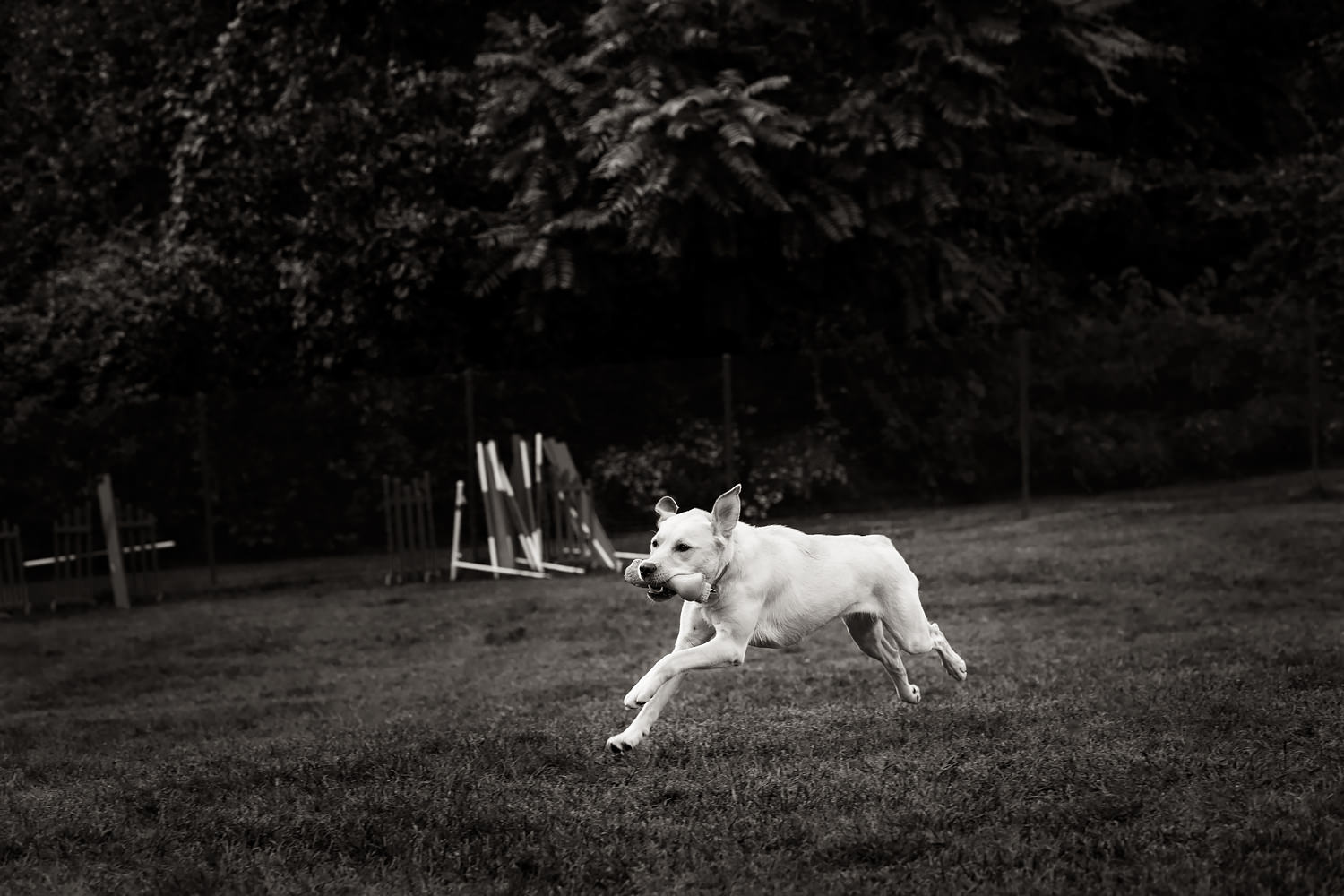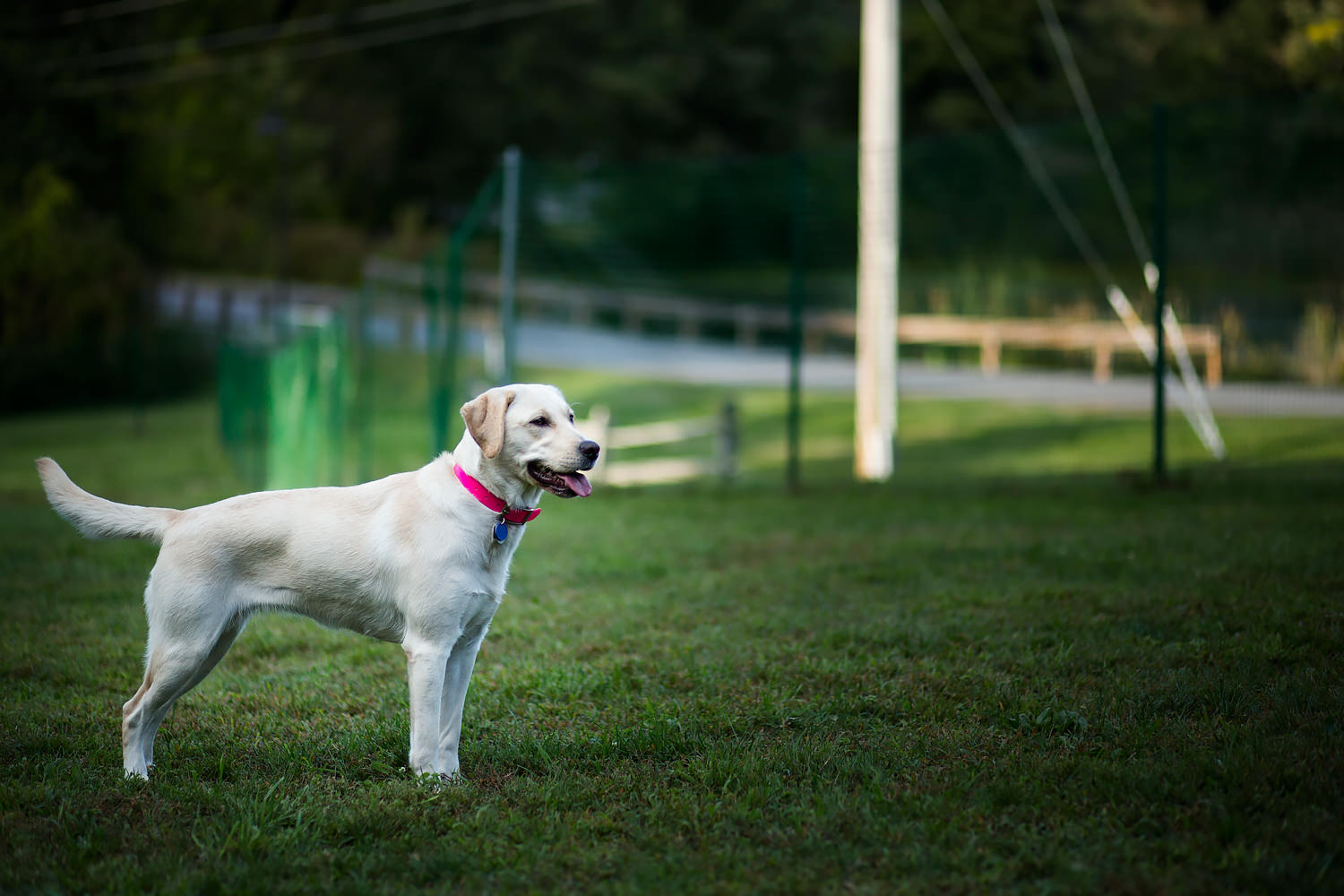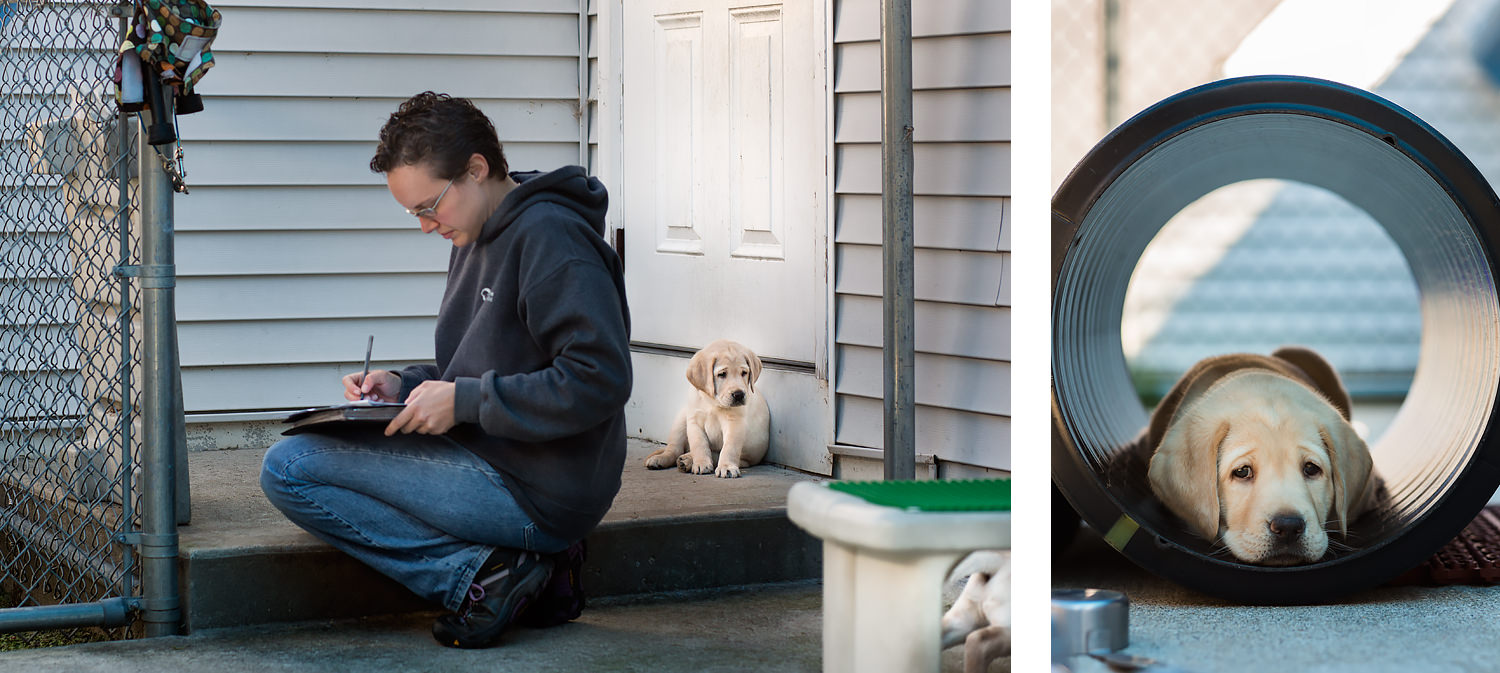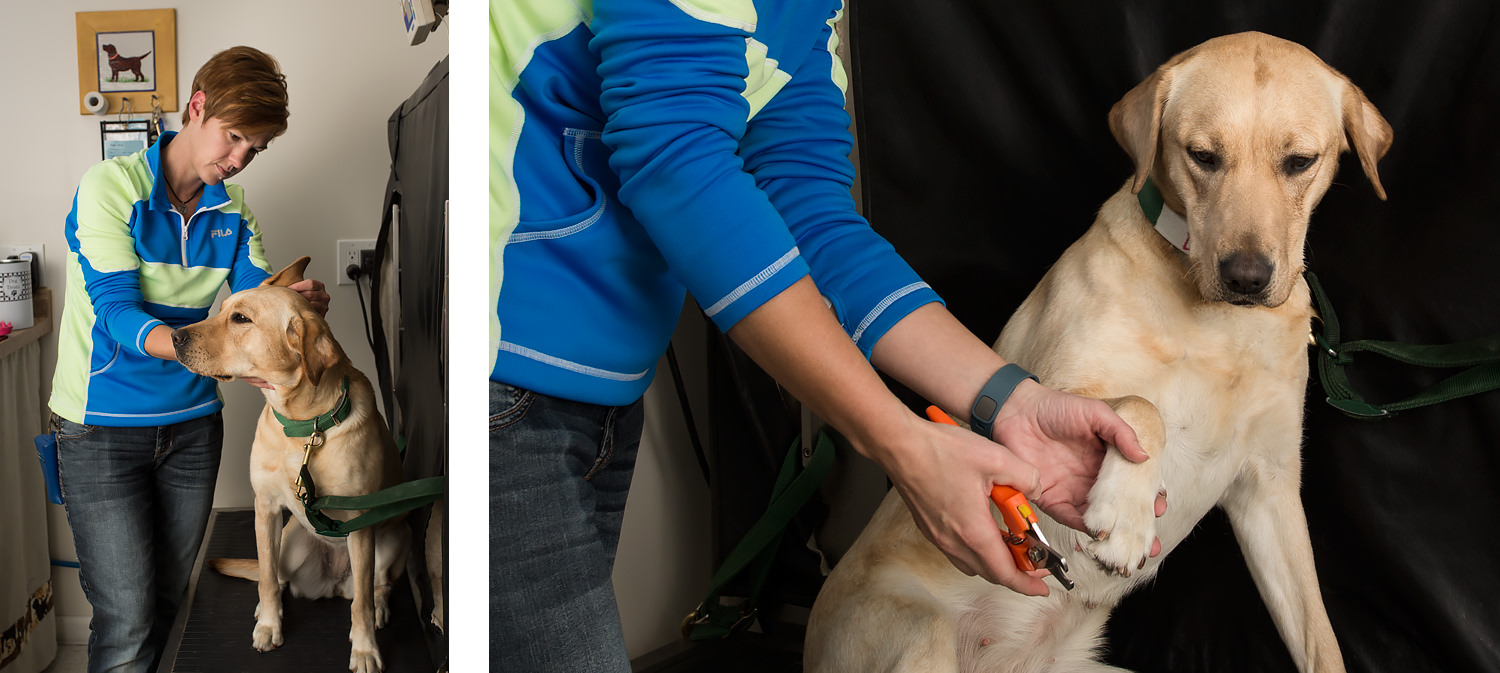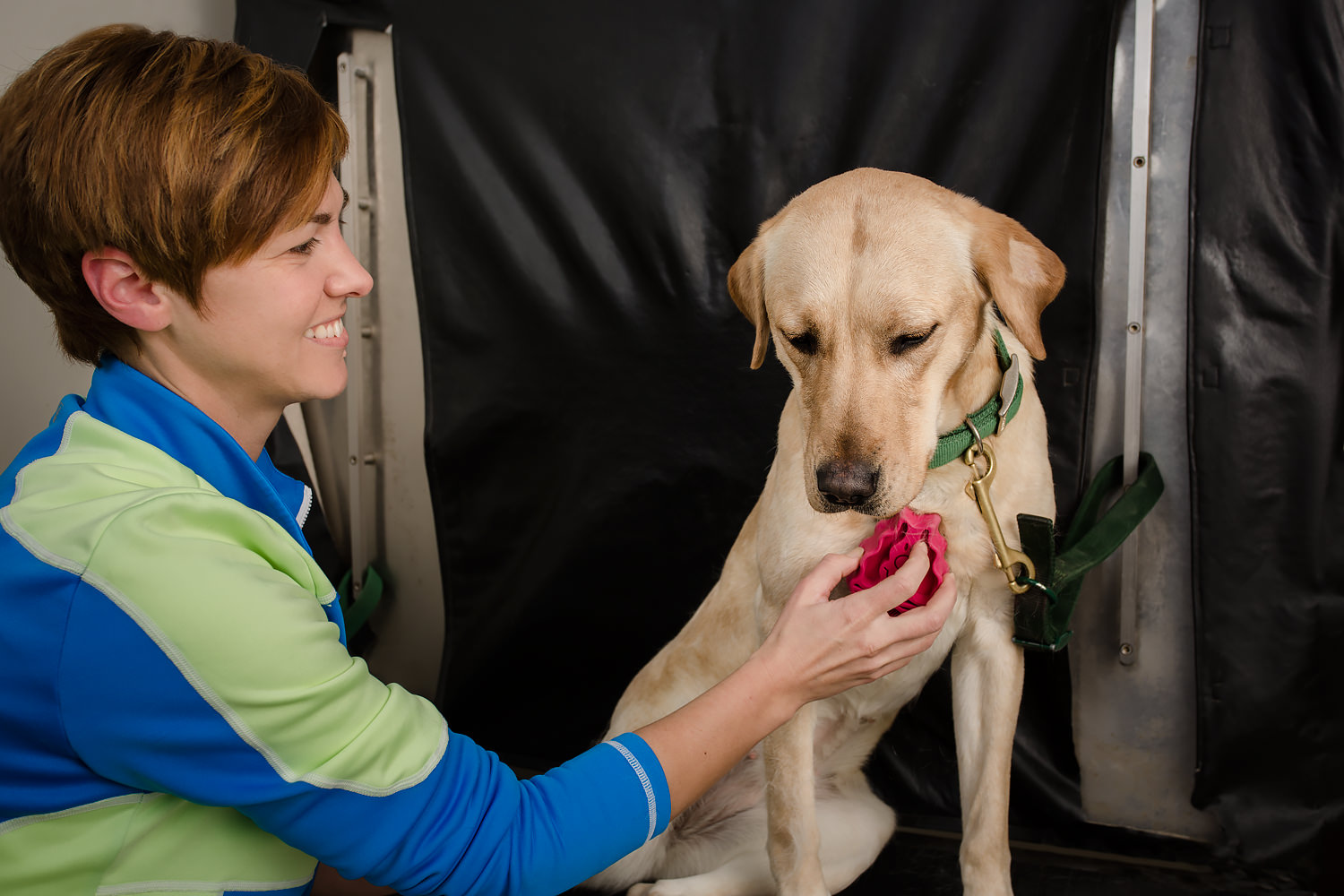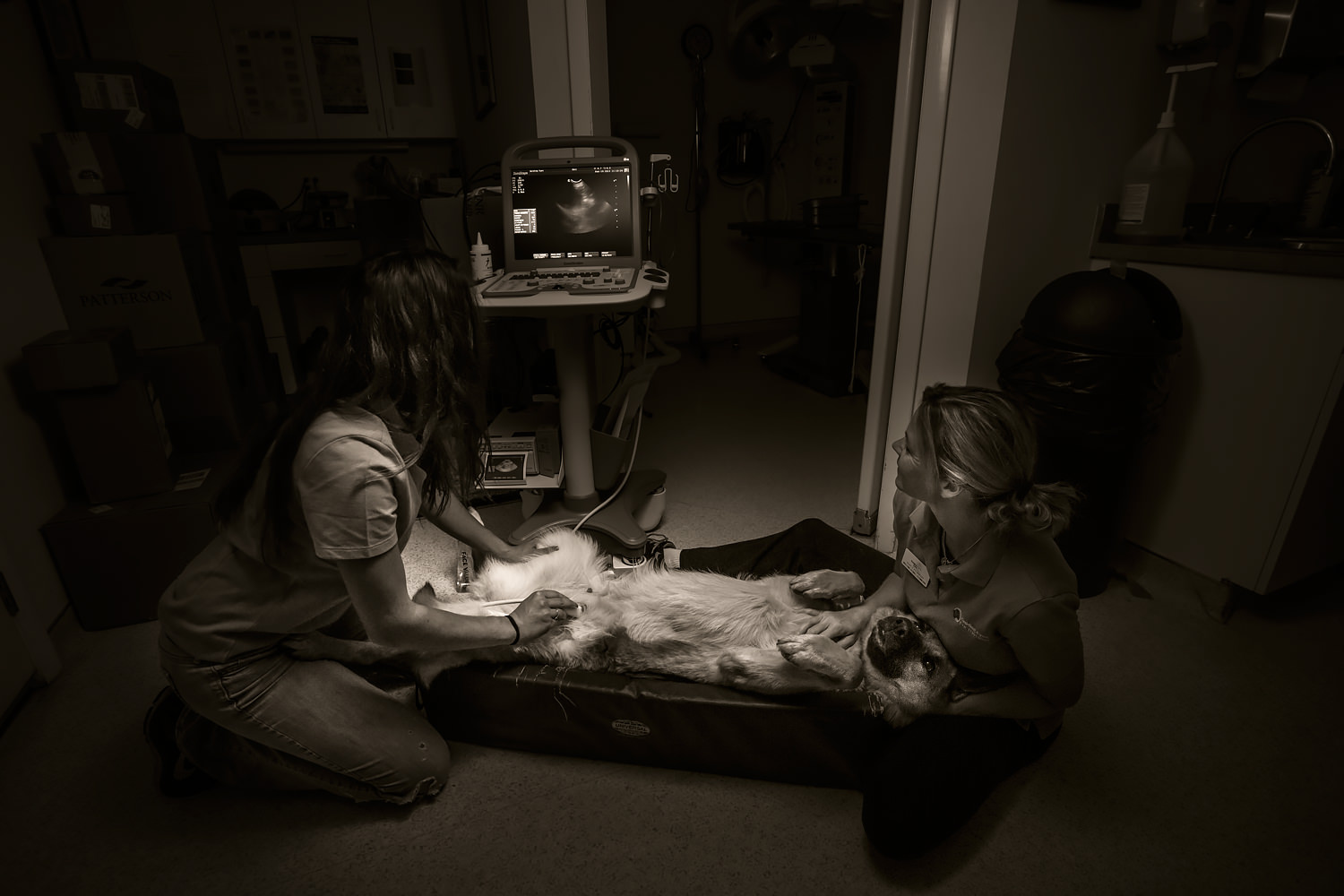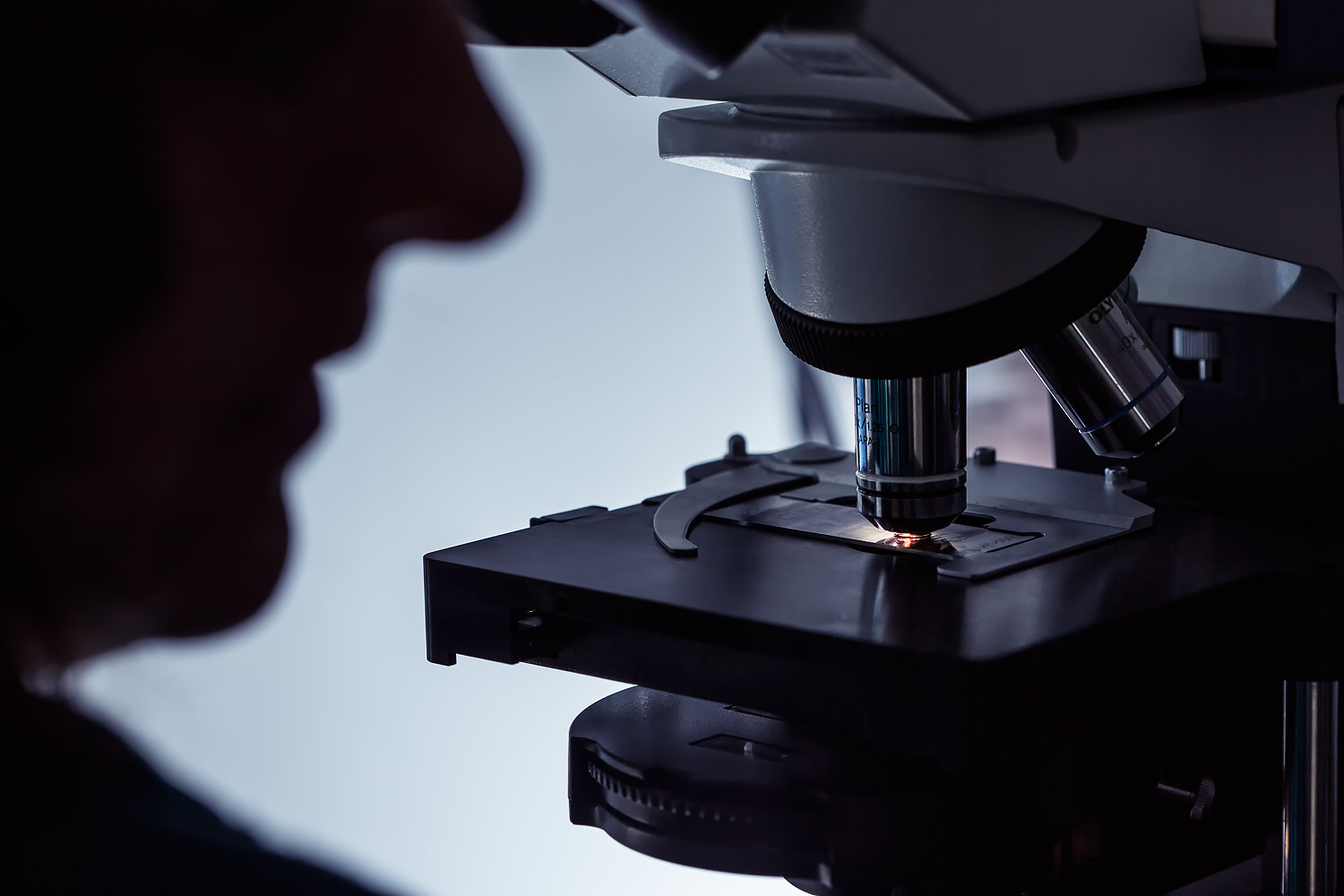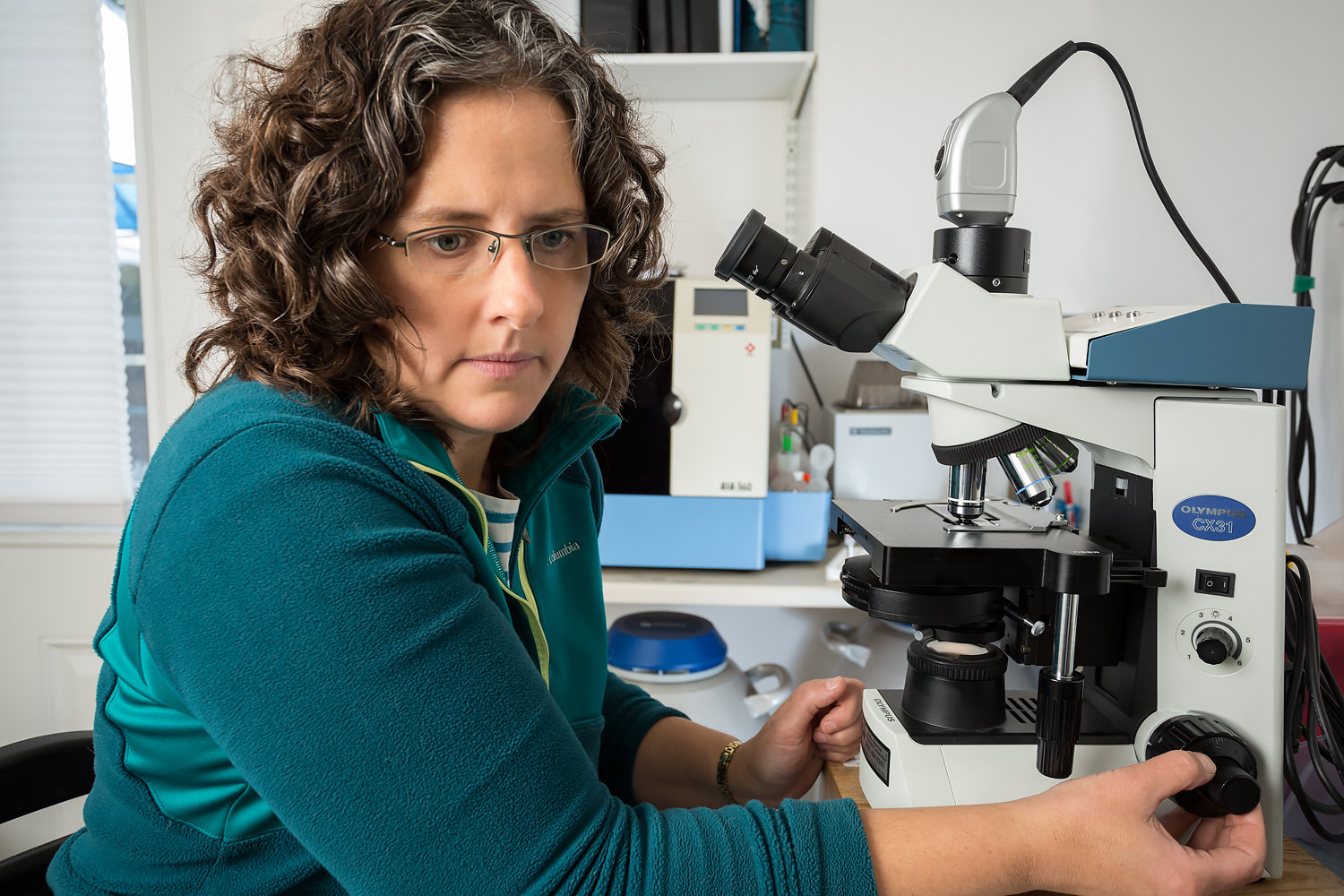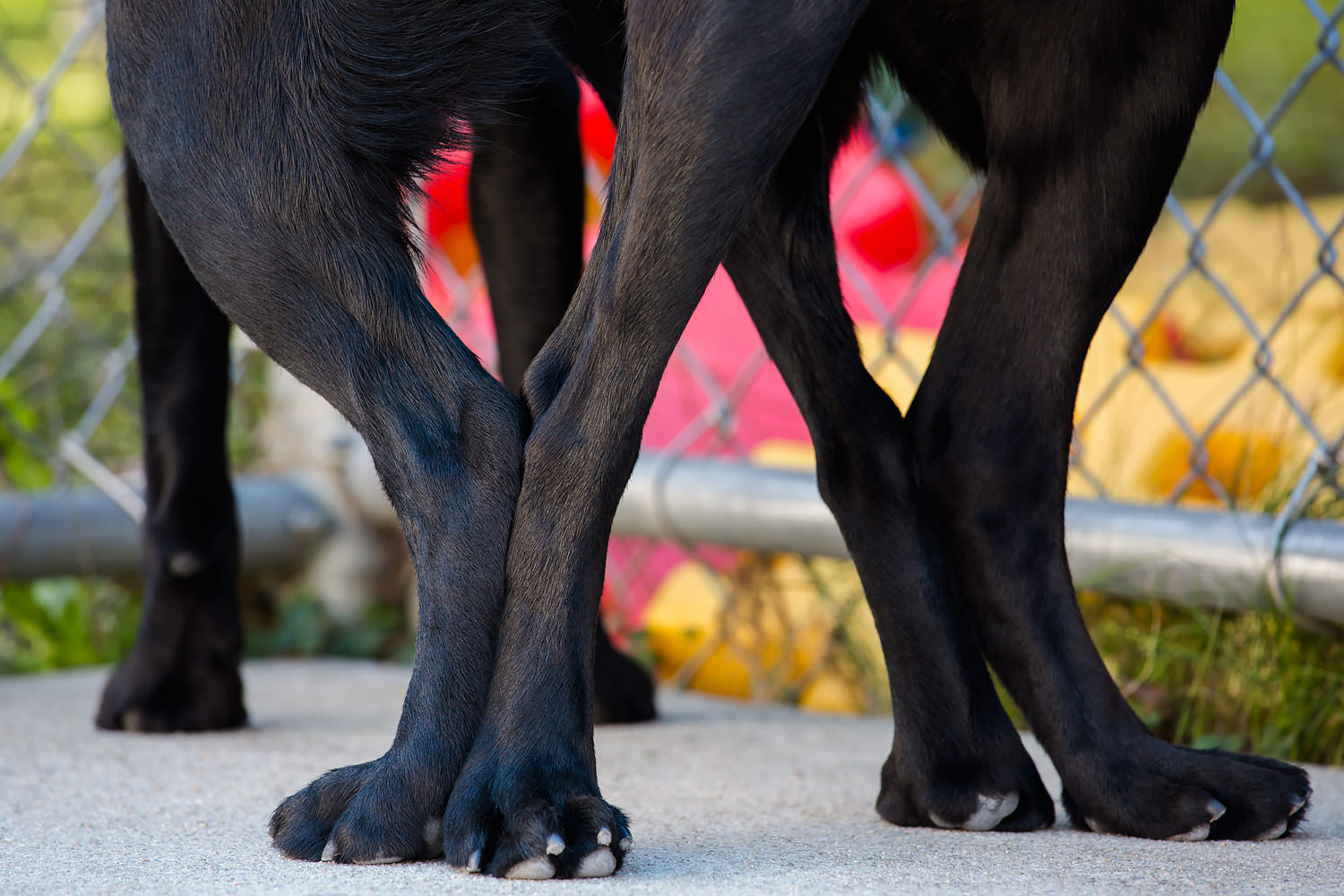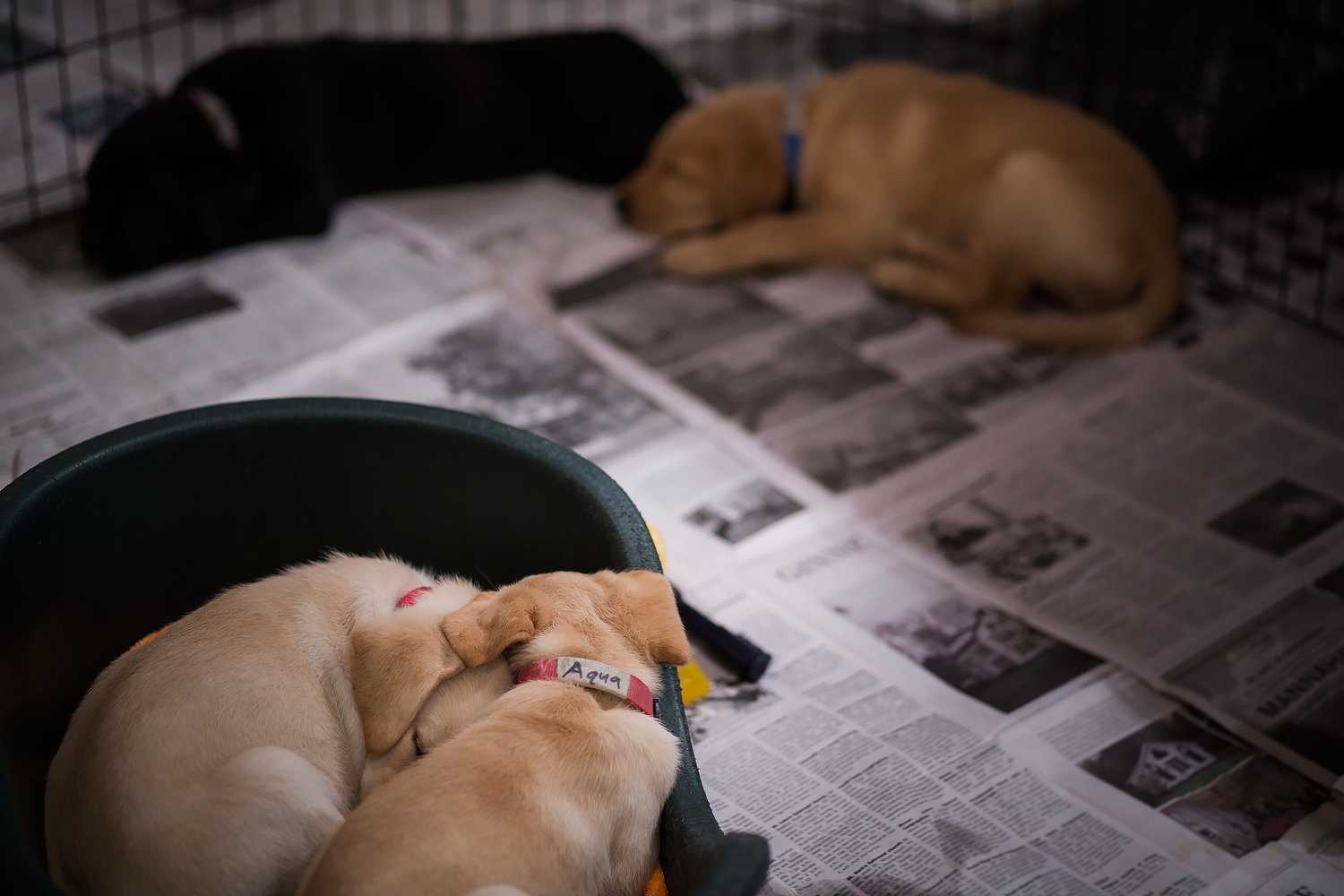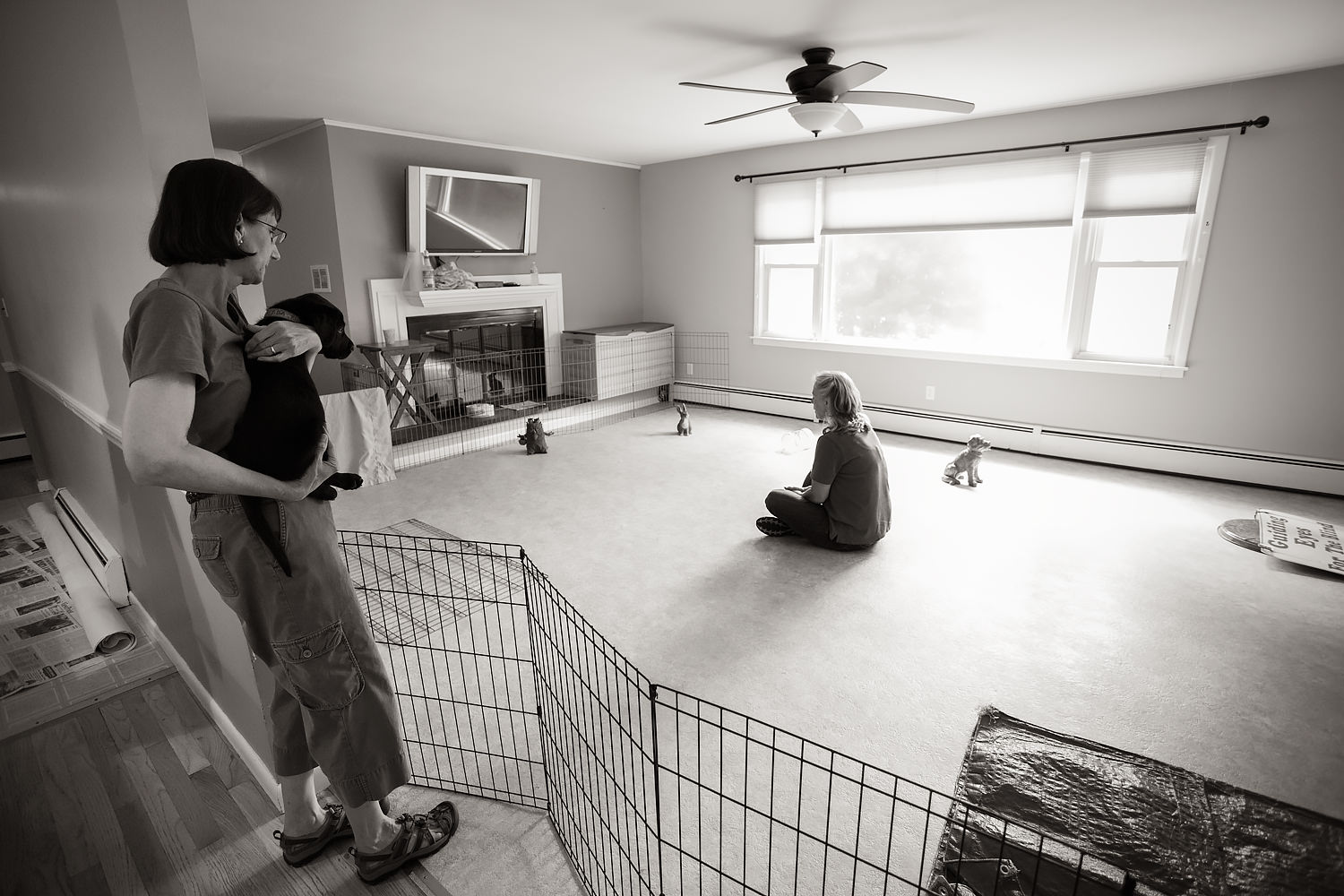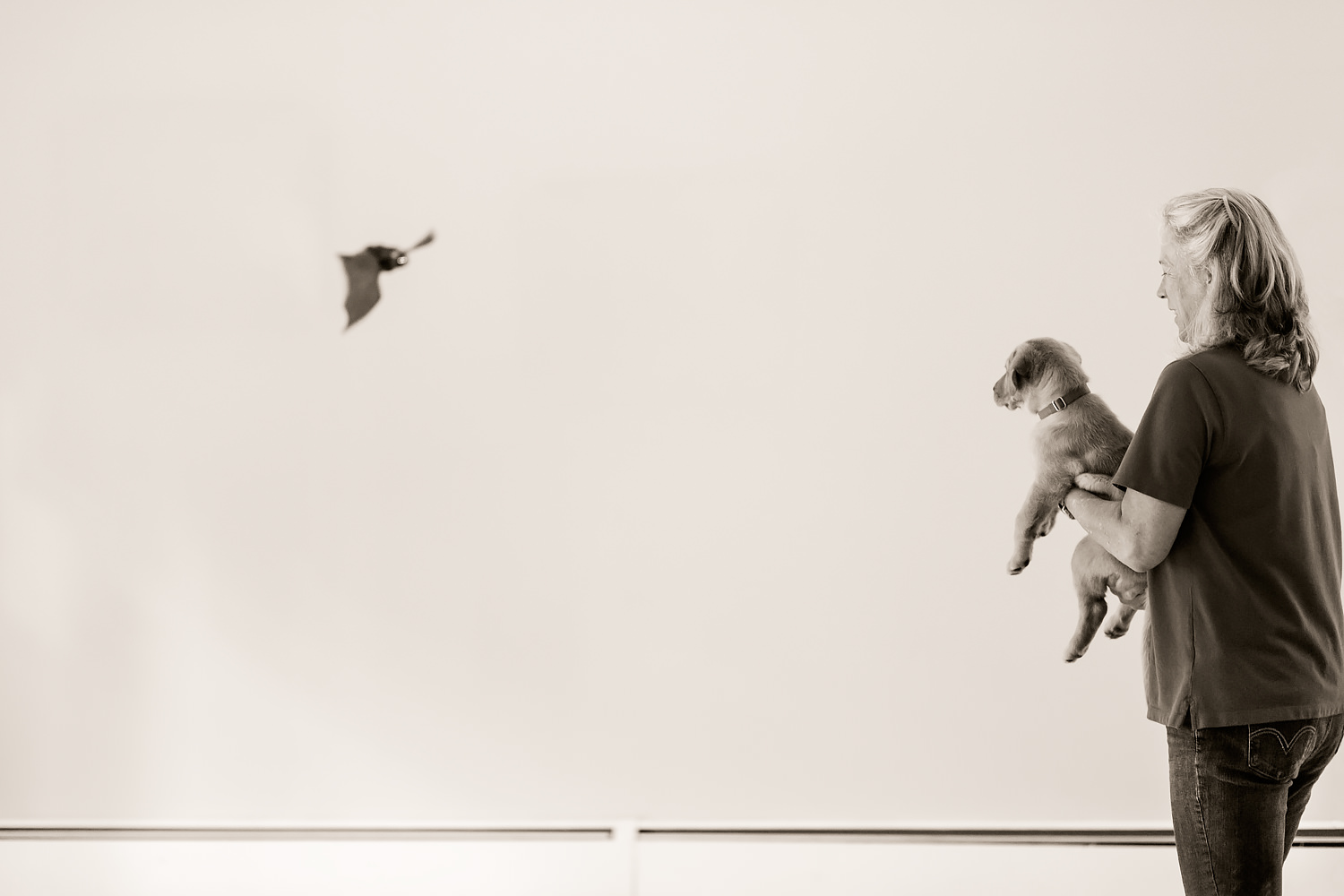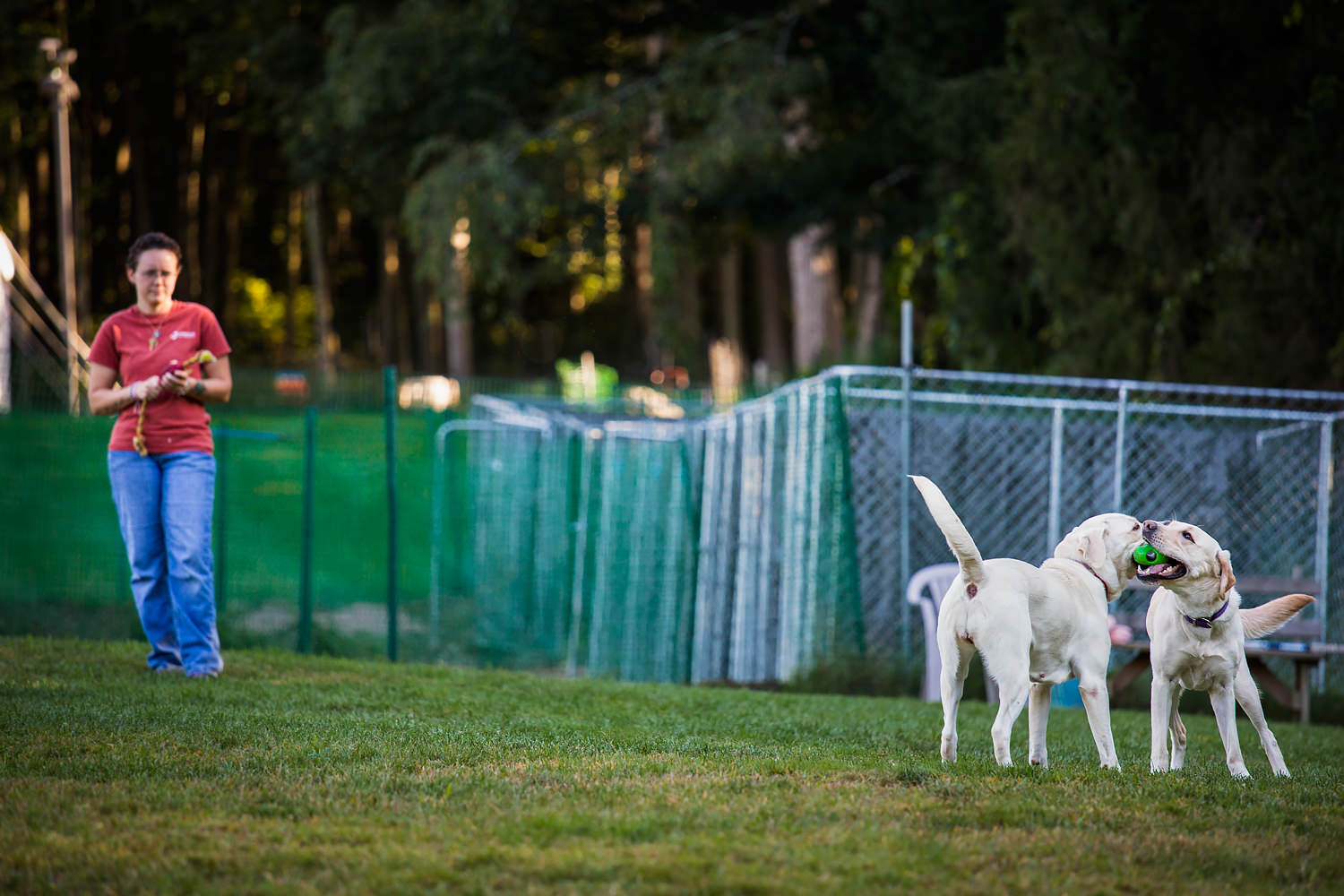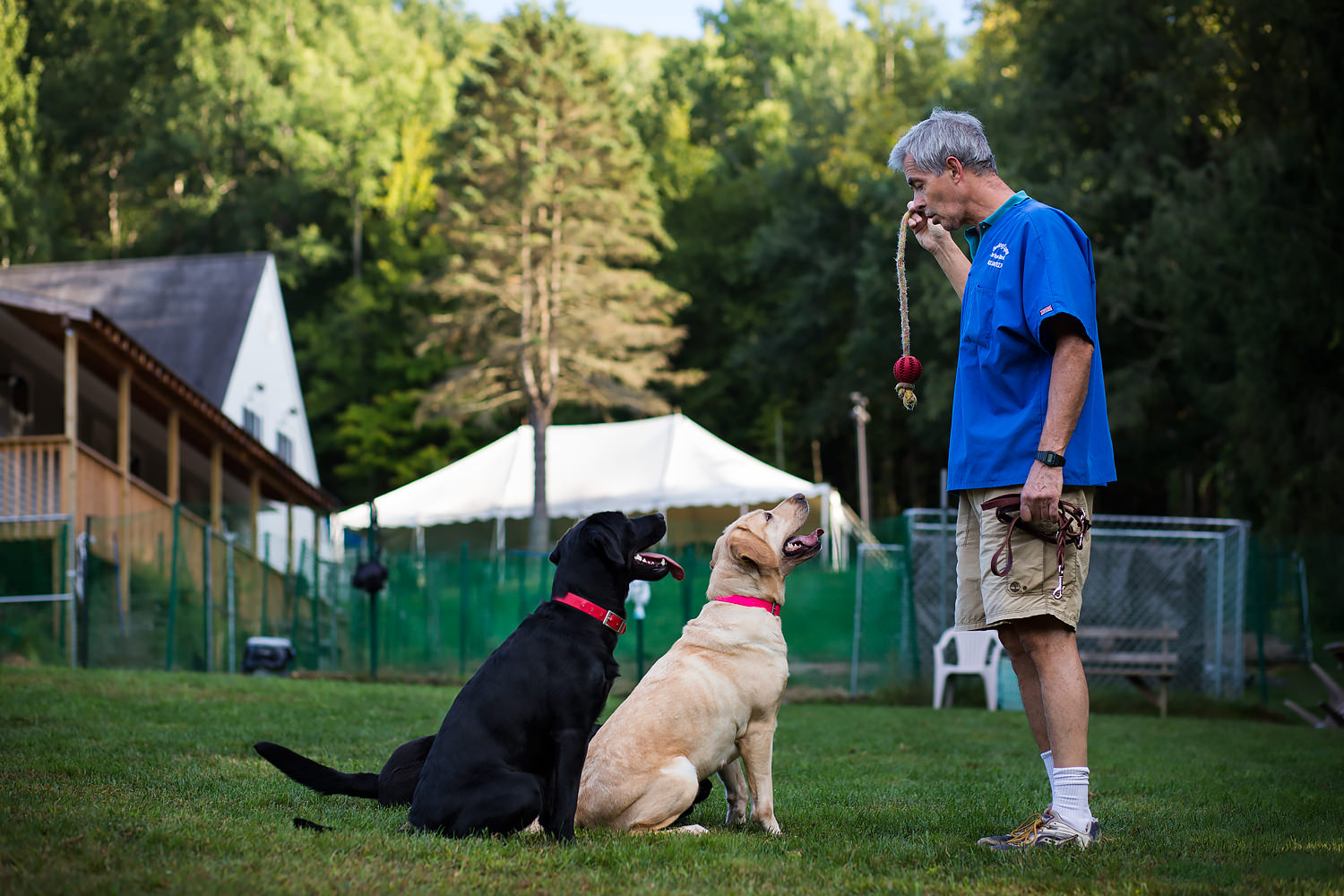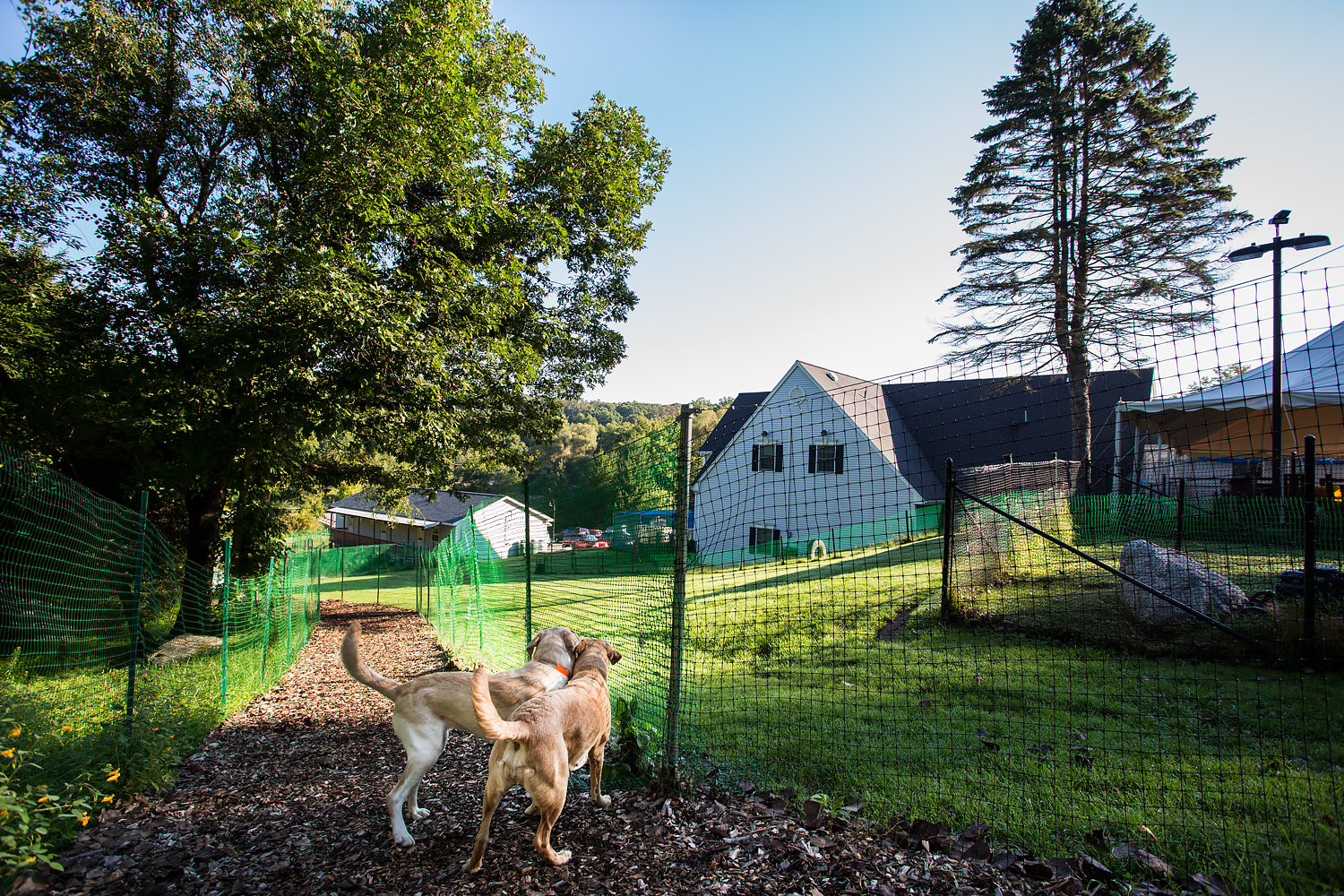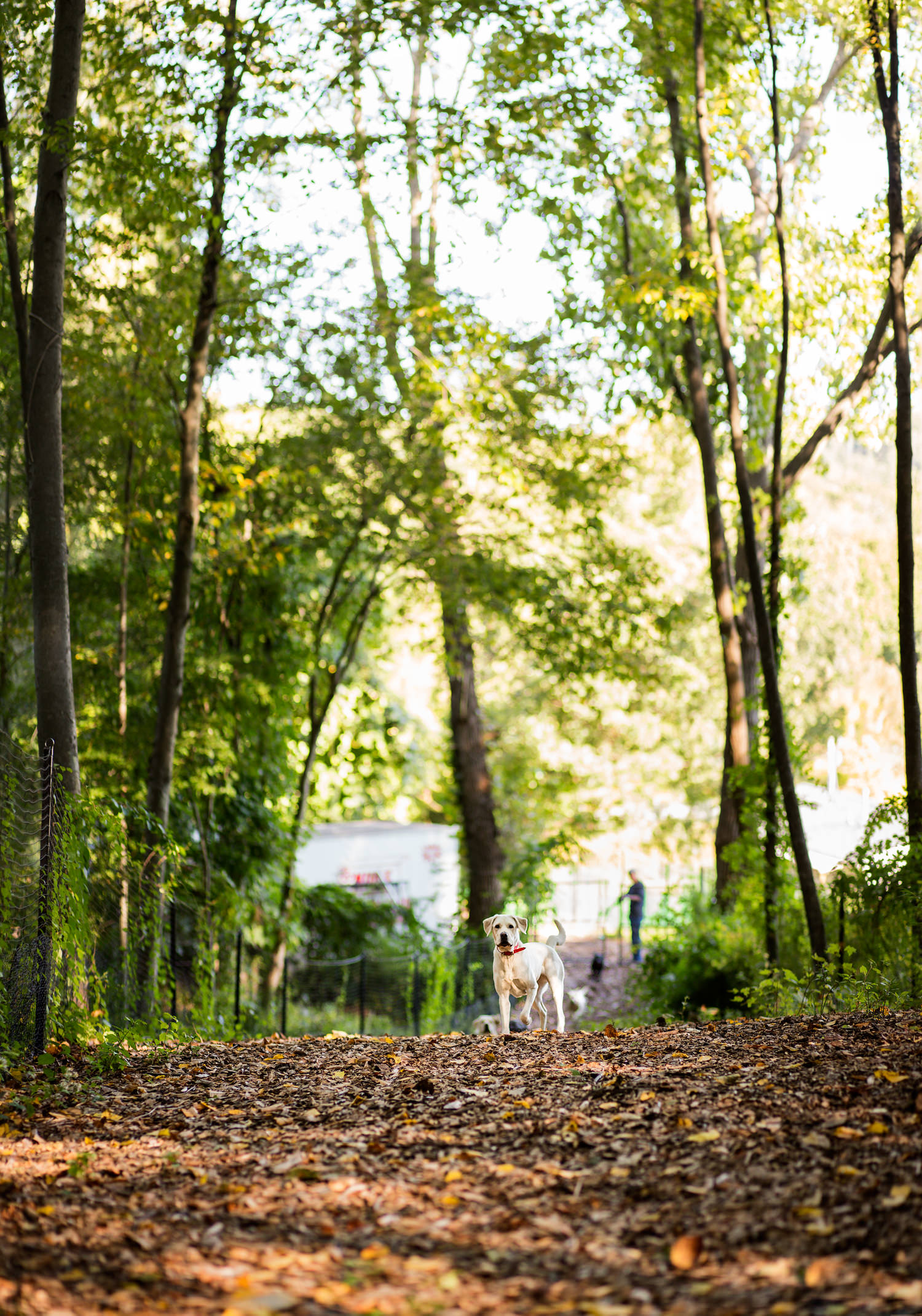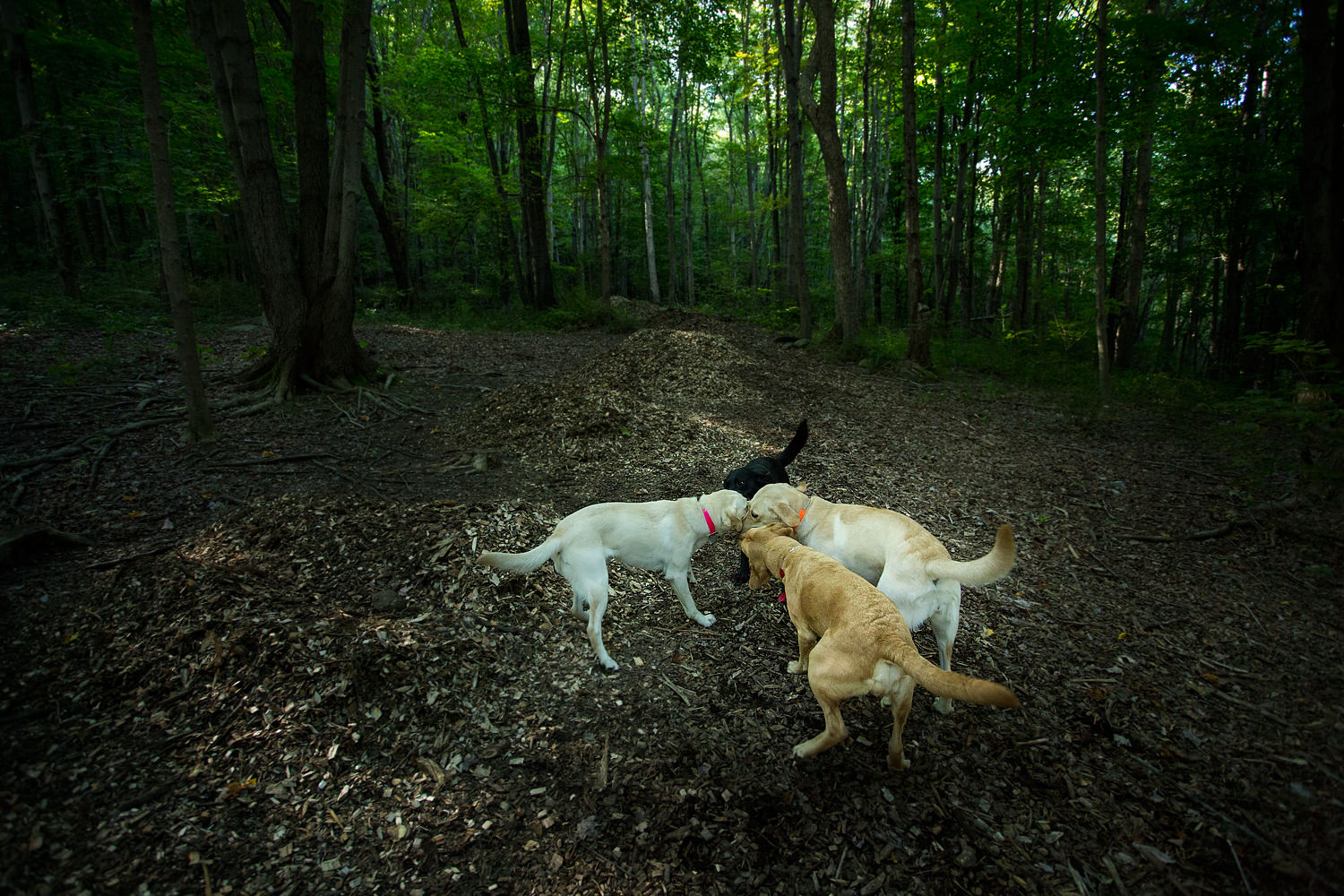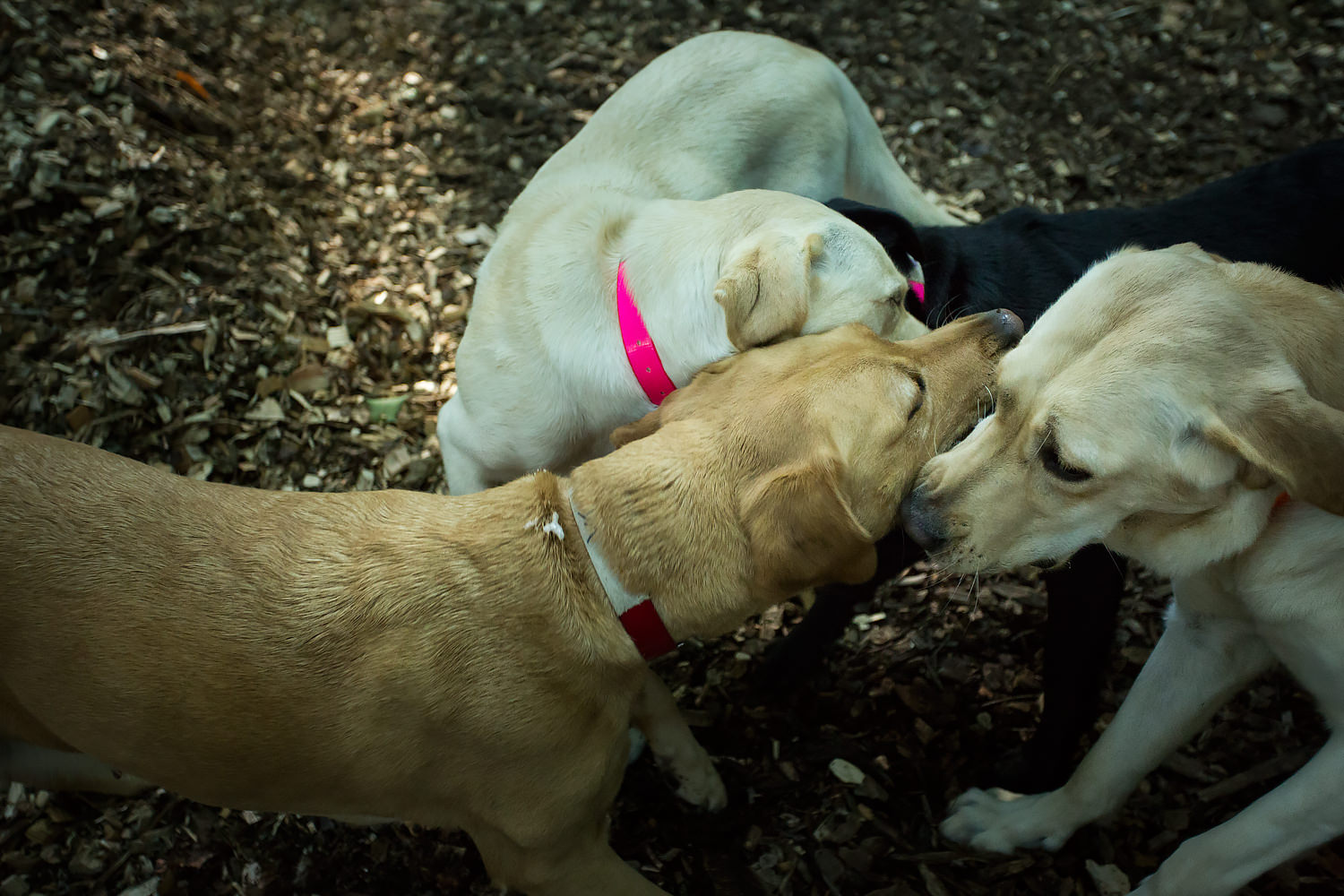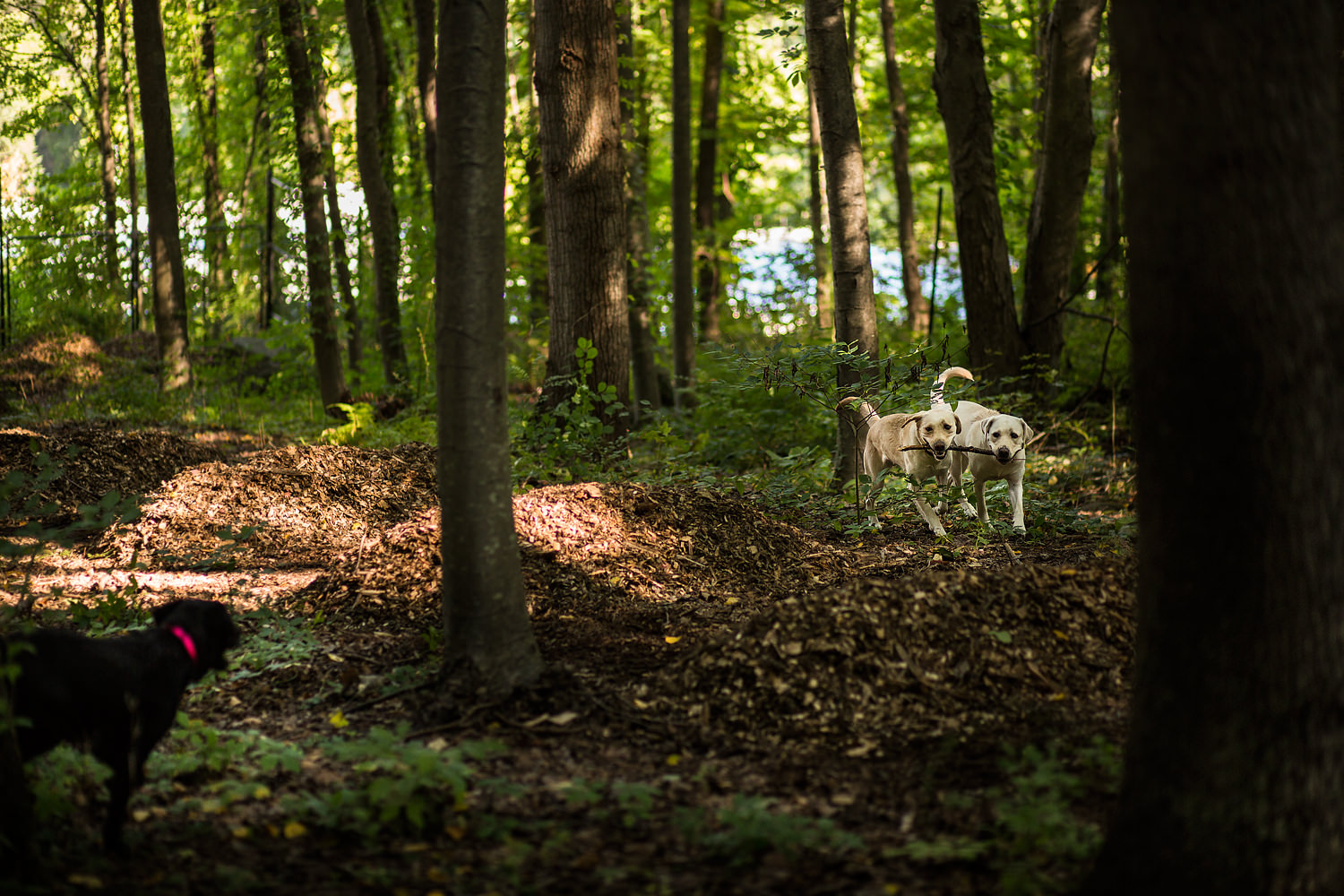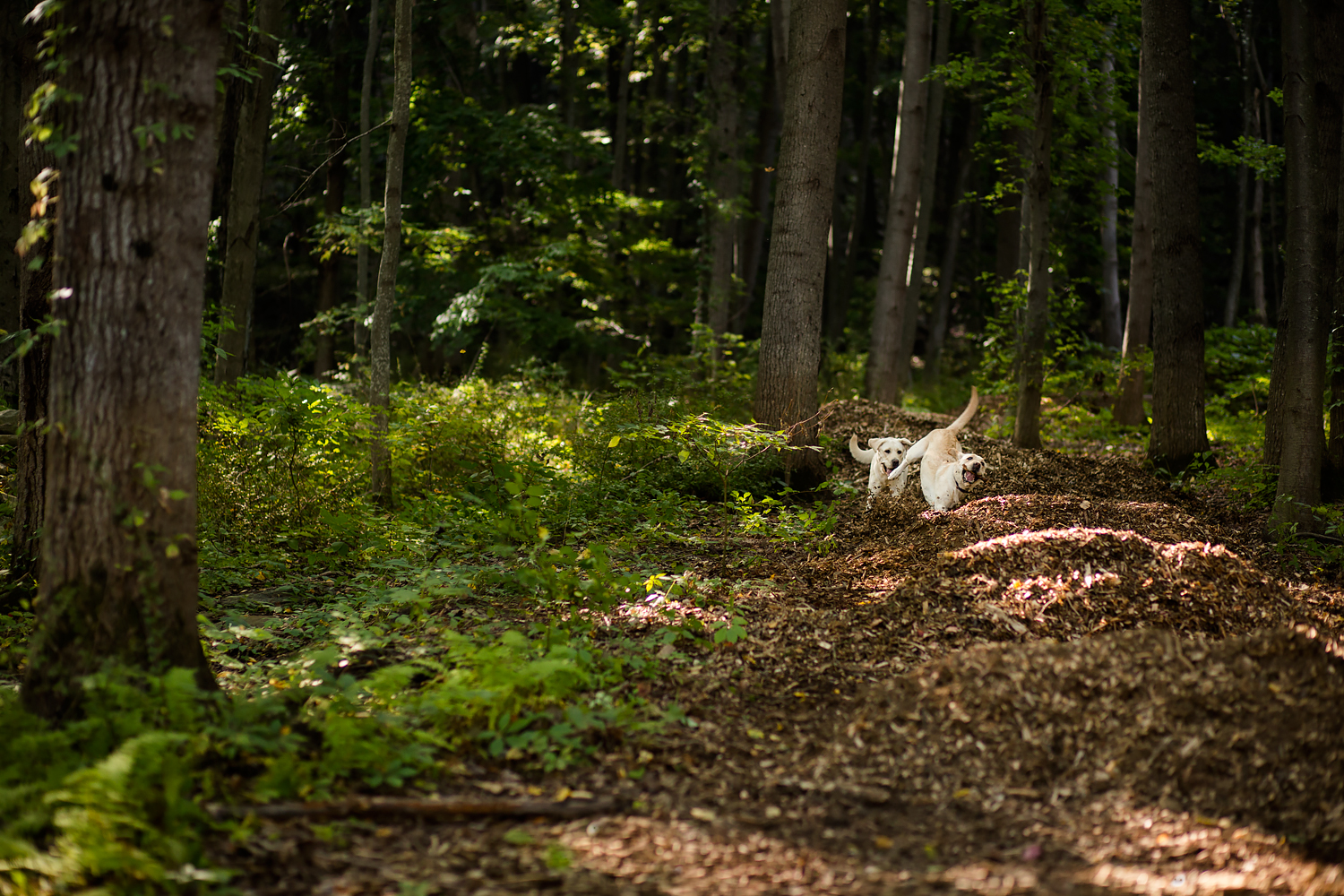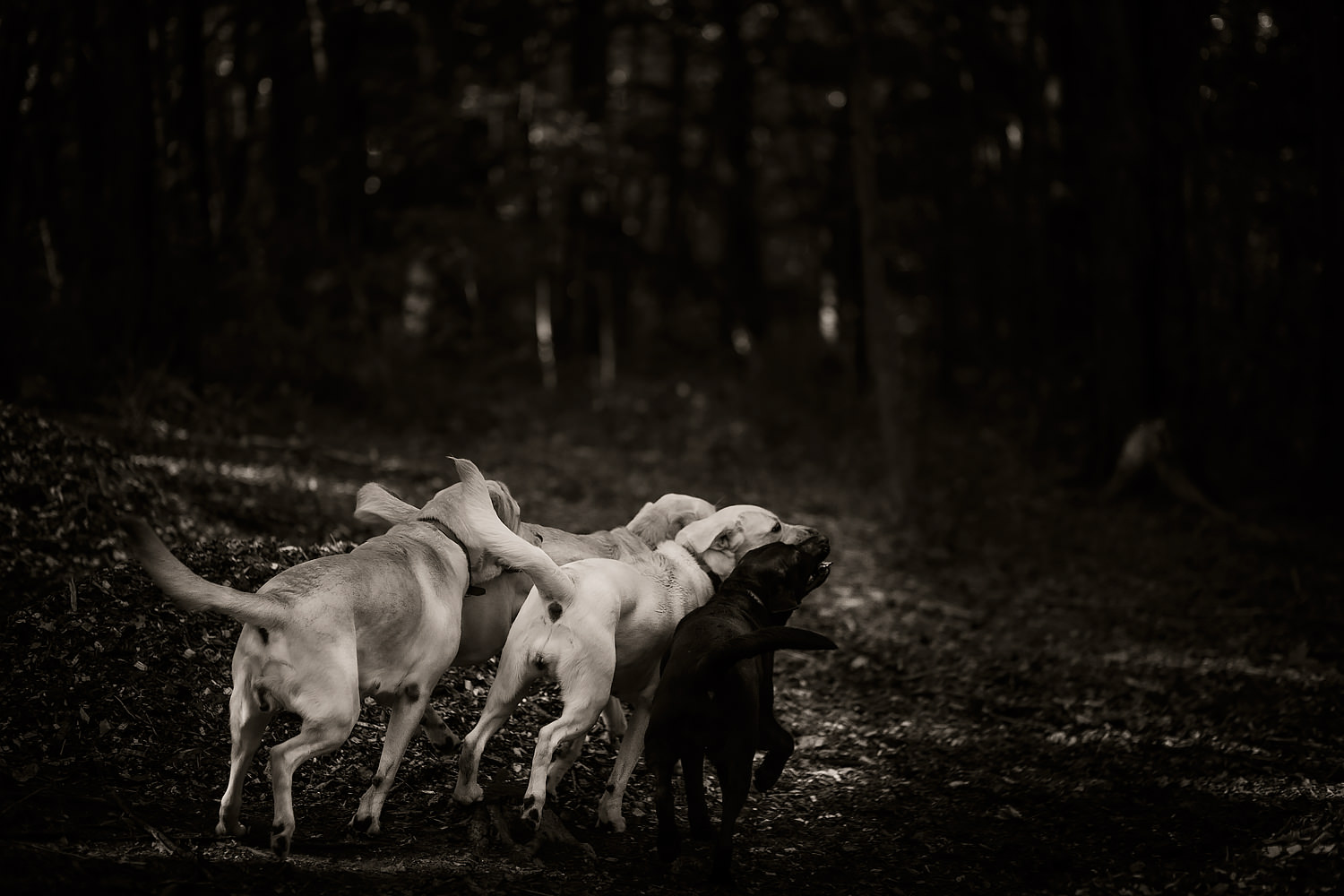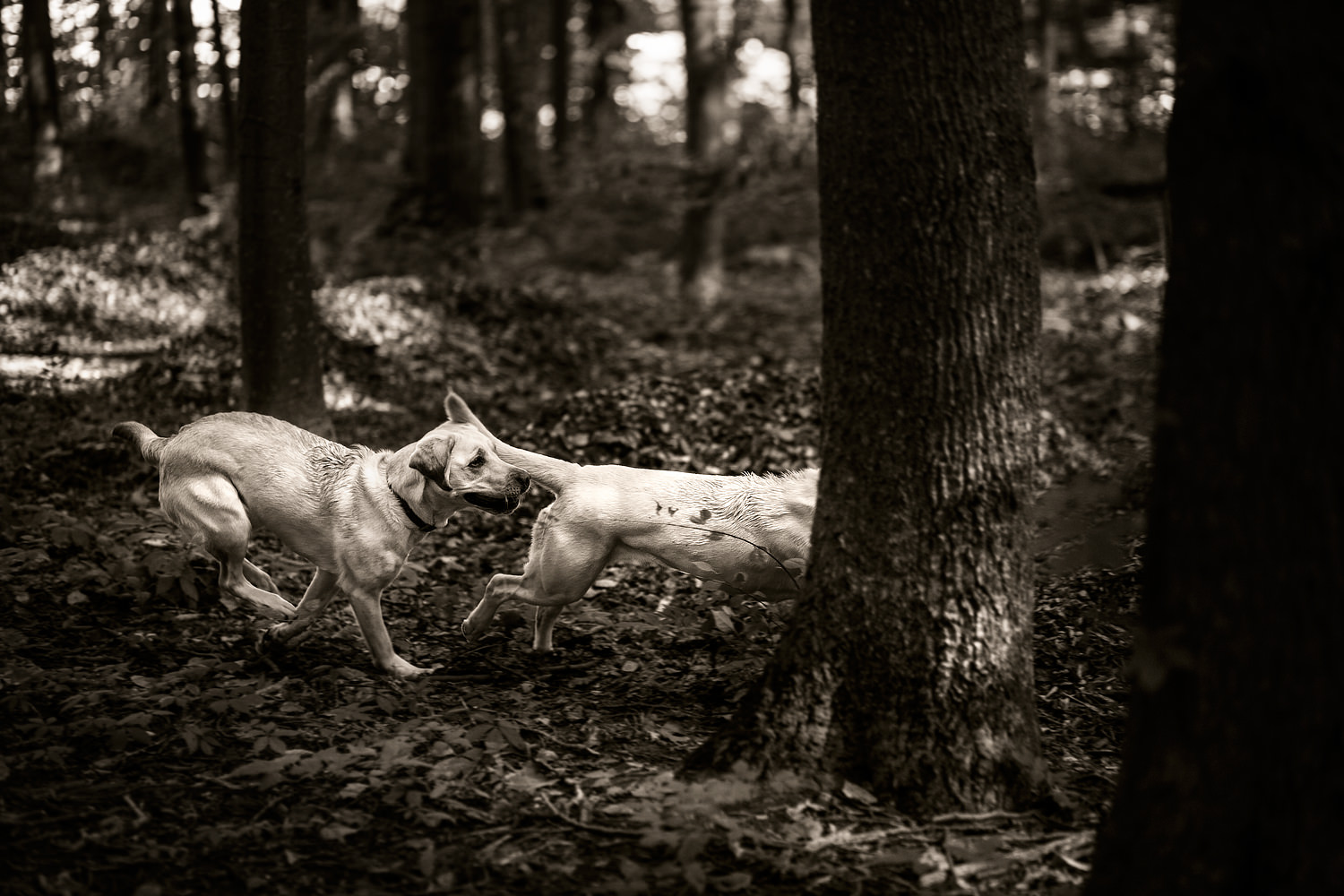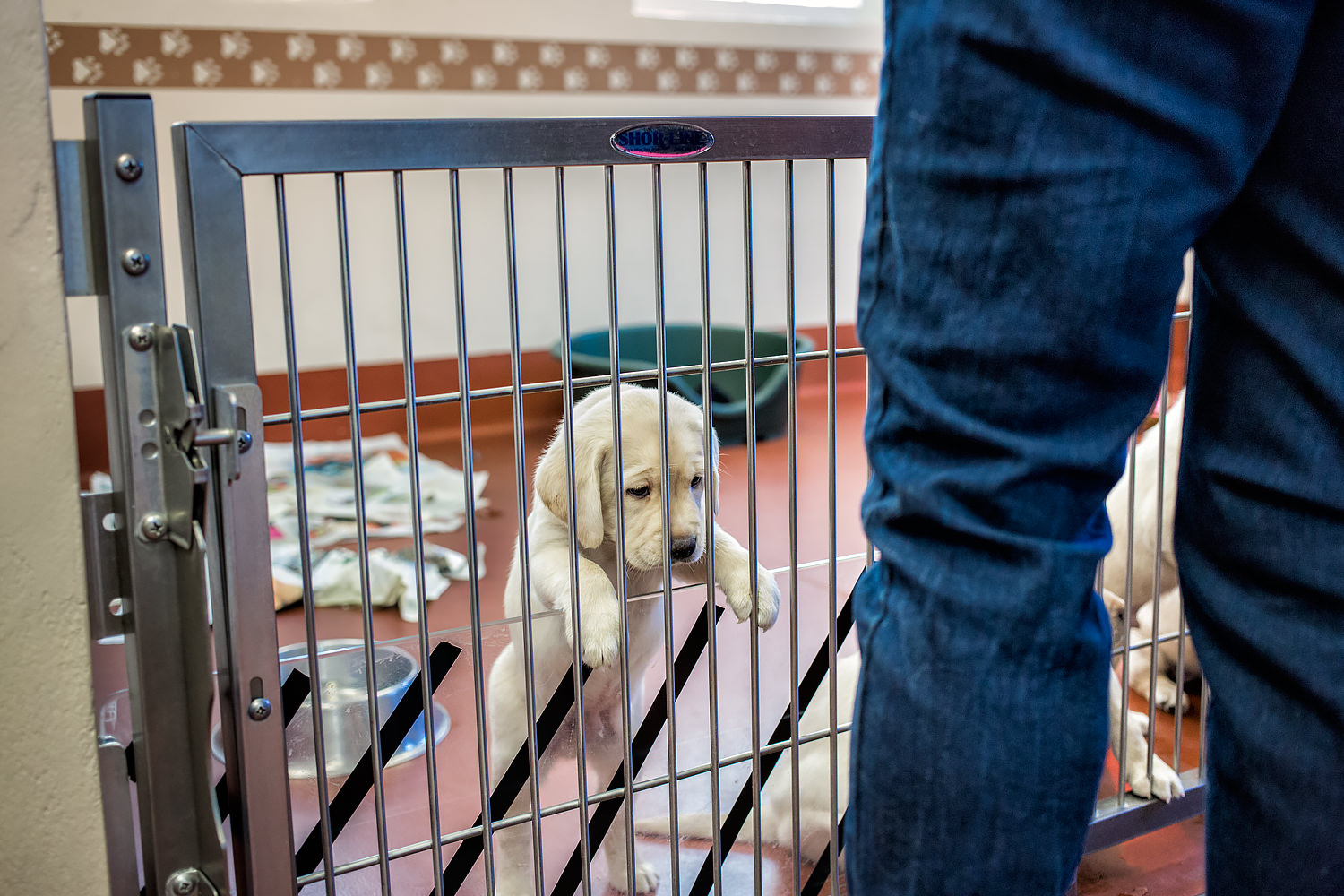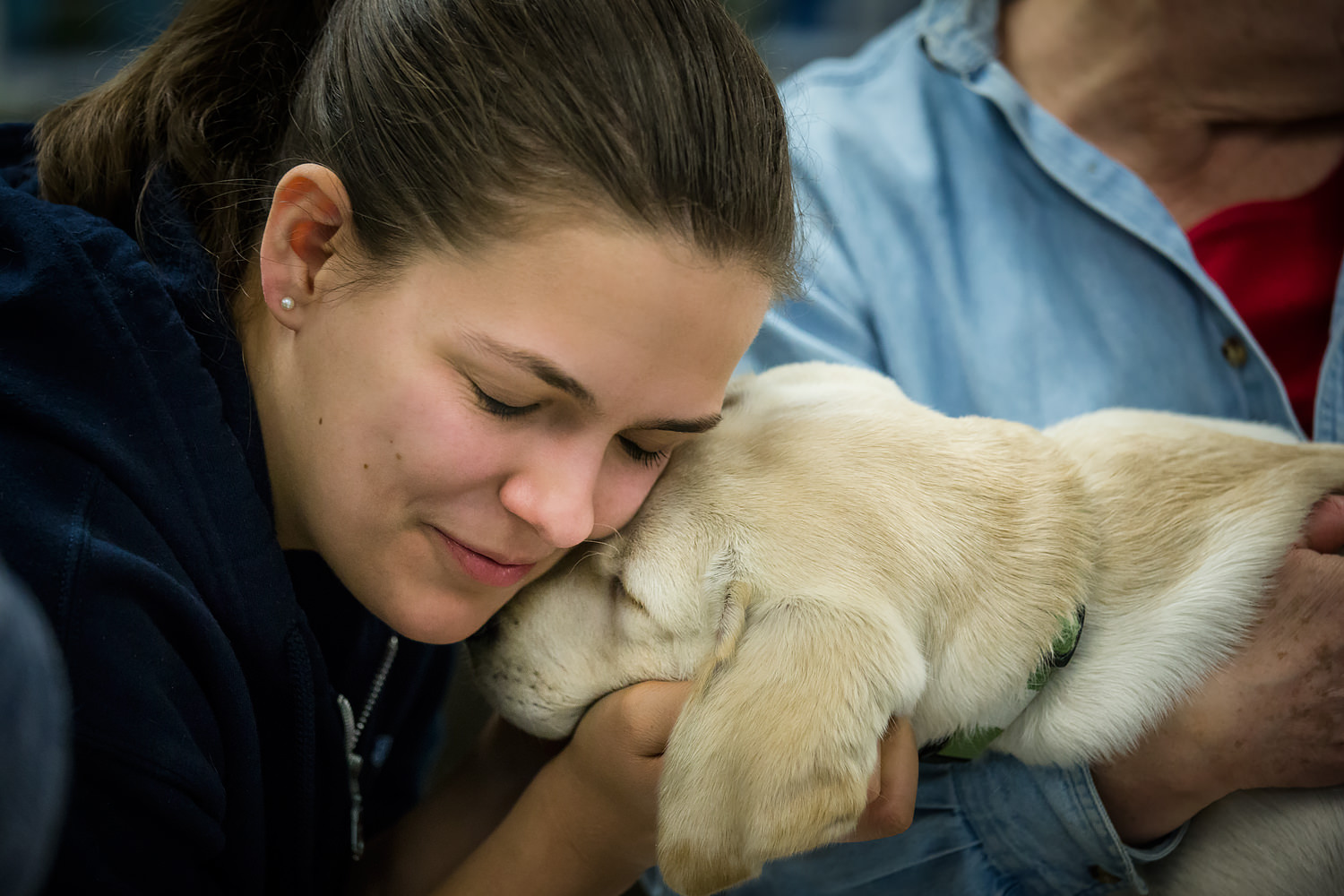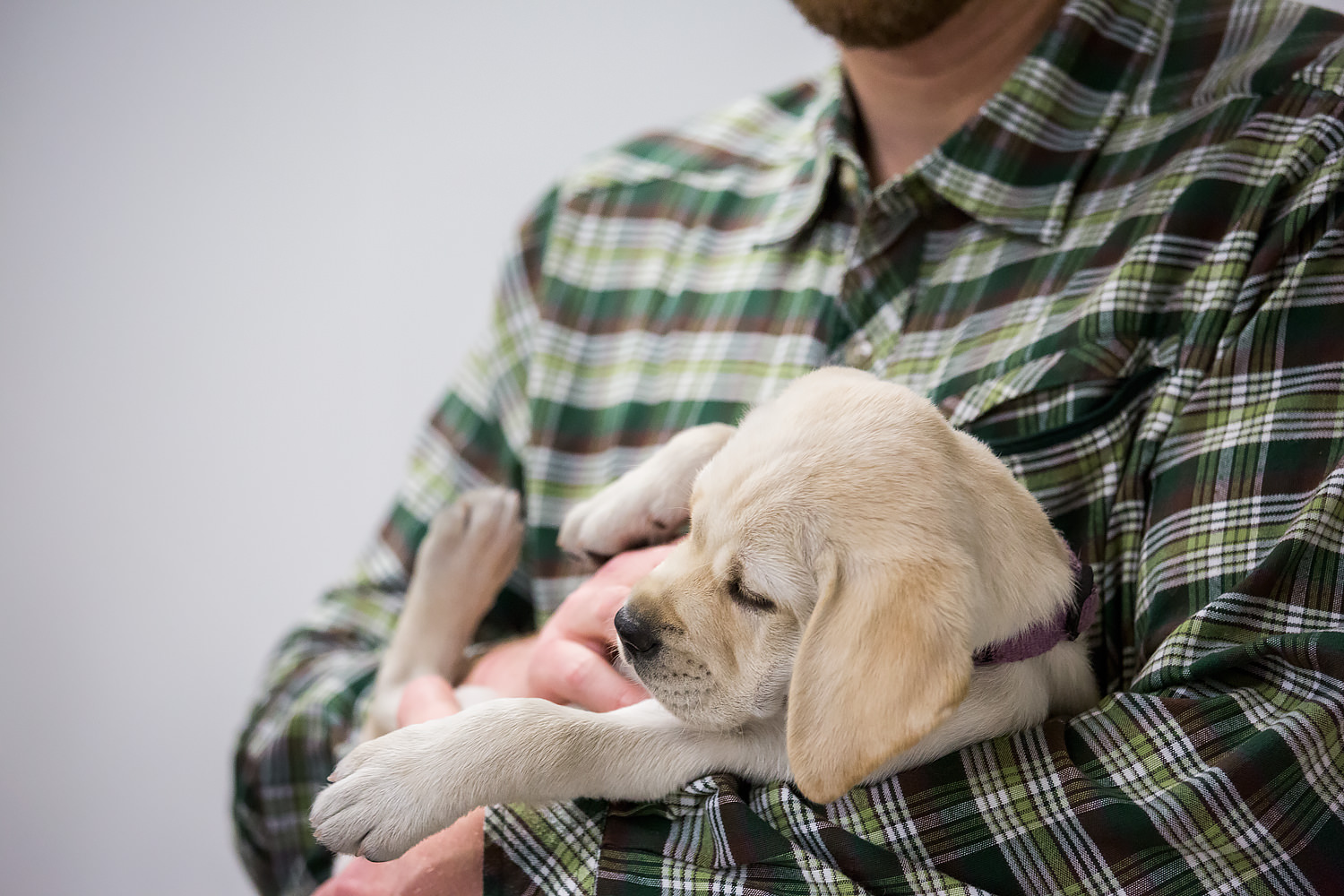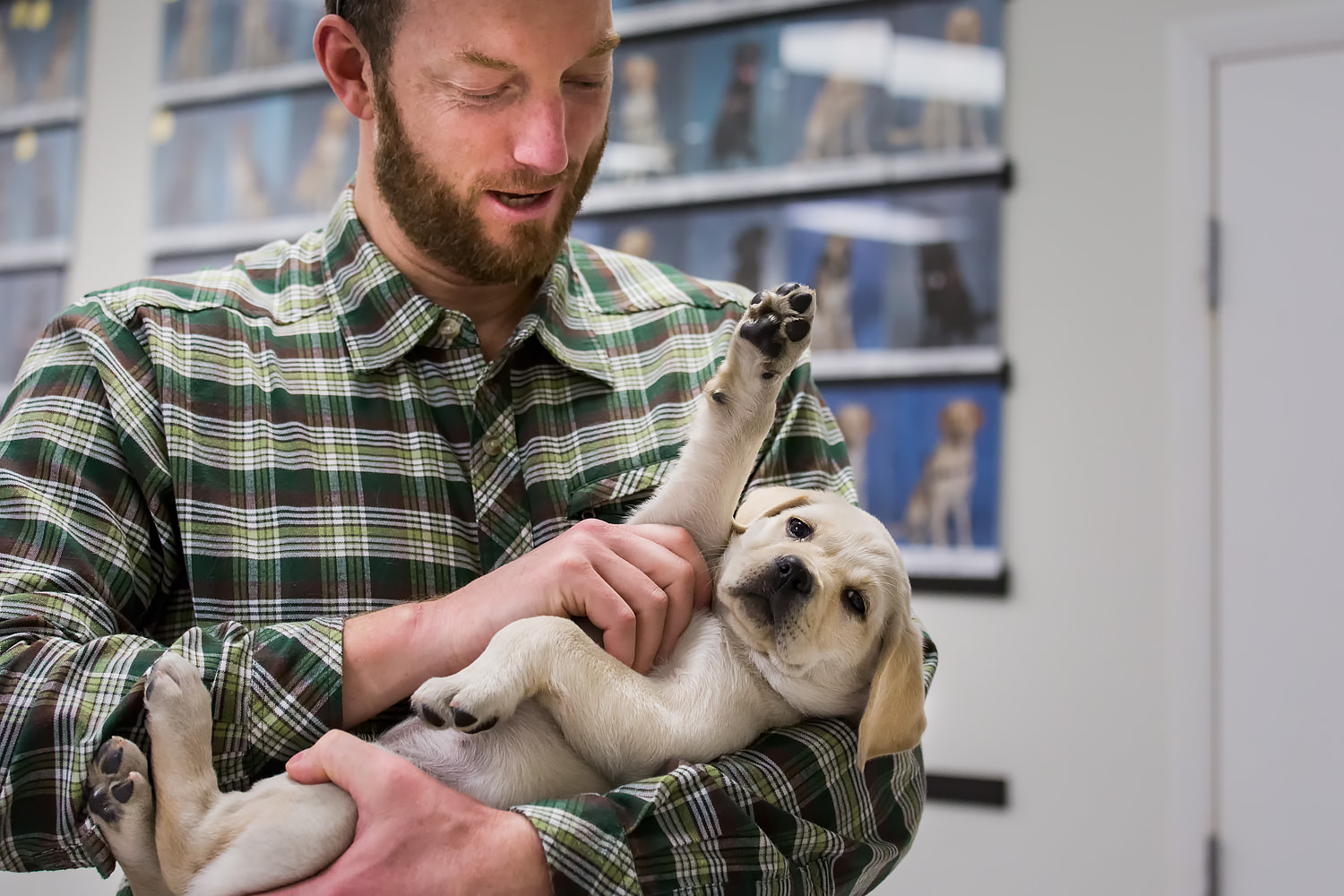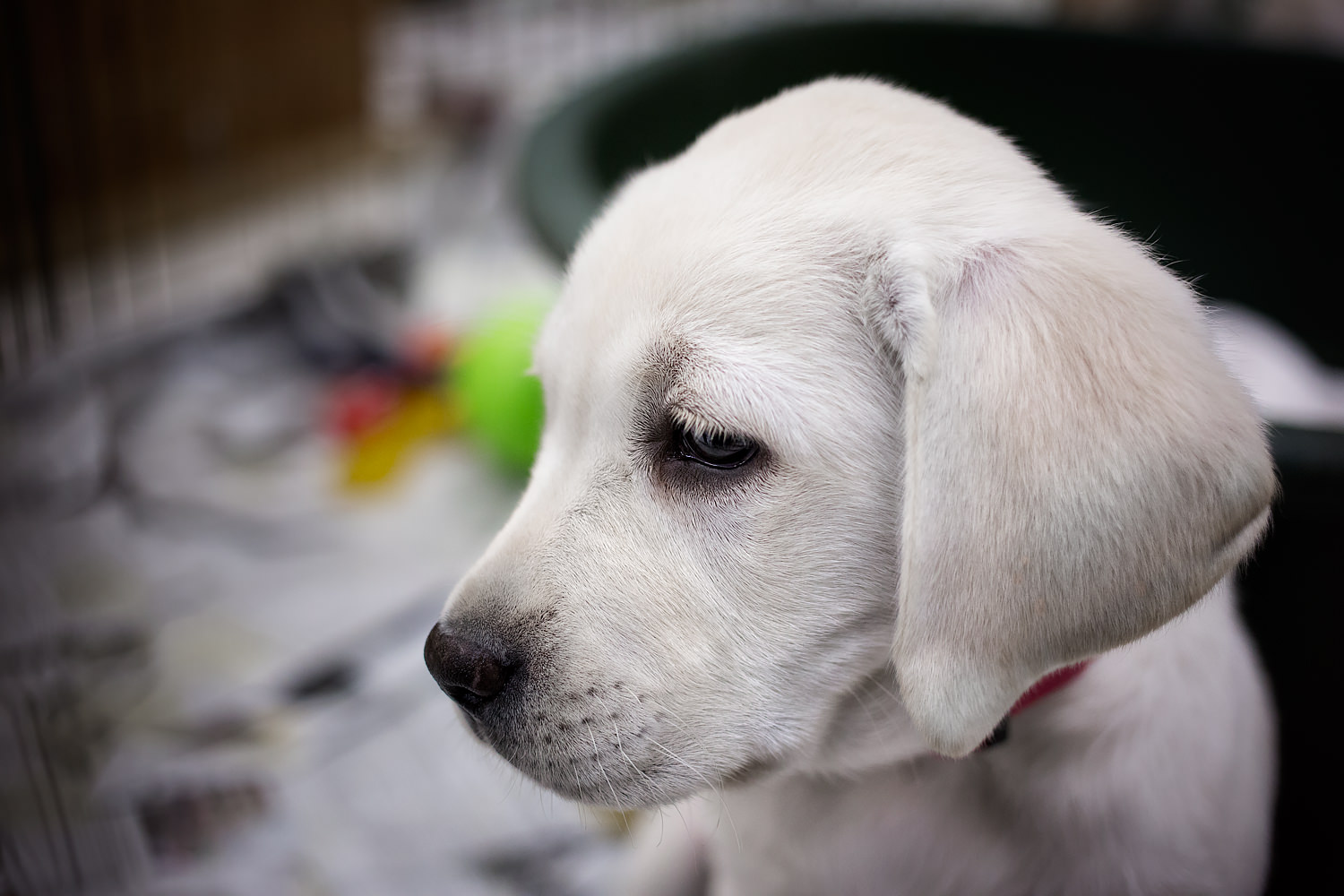In Part 1 we got a glimpse inside the whelping kennel at Guiding Eyes’ Canine Development Center (CDC). Down the hall and a flight of stairs, the breeding kennel runs in parallel. The two sides feed each other in support of a common mission but function independently day-to-day. Where the whelping kennel caters to broods and pups during the birthing, neonatal, and earliest socialization stages of development, the breeding kennel serves a complementary but developmentally distinct array of needs in the life of a service dog. Daily breeding kennel activities include :
- continuation of socialization for pups coming out of the whelping kennel
- evaluation of pups for placement in the volunteer puppy raising program
- breeder evaluation for pups returning from the puppy raising program
- breeding colony foster placement and coordination
- cryogenics and reproduction
- veterinary care for all dogs on campus and in the breeding colony
- volunteer outreach
Not to mention feeding, cleaning, and exercising all pups, broods, and studs on campus. In the universe of dogdom, there may be no greater juggling act. And as observed in the whelping kennel, it all happens with a surprising degree of precision and an endless amount of love for each and every dog.
For all this to get done in a day, work starts early.
(to enlarge images and view in slideshow mode without text, simply click on an image)
On my pre-dawn walk up the driveway from the guest house across the street, I could hear the unmistakable sound of movement coming from the dark woods. A bear!?
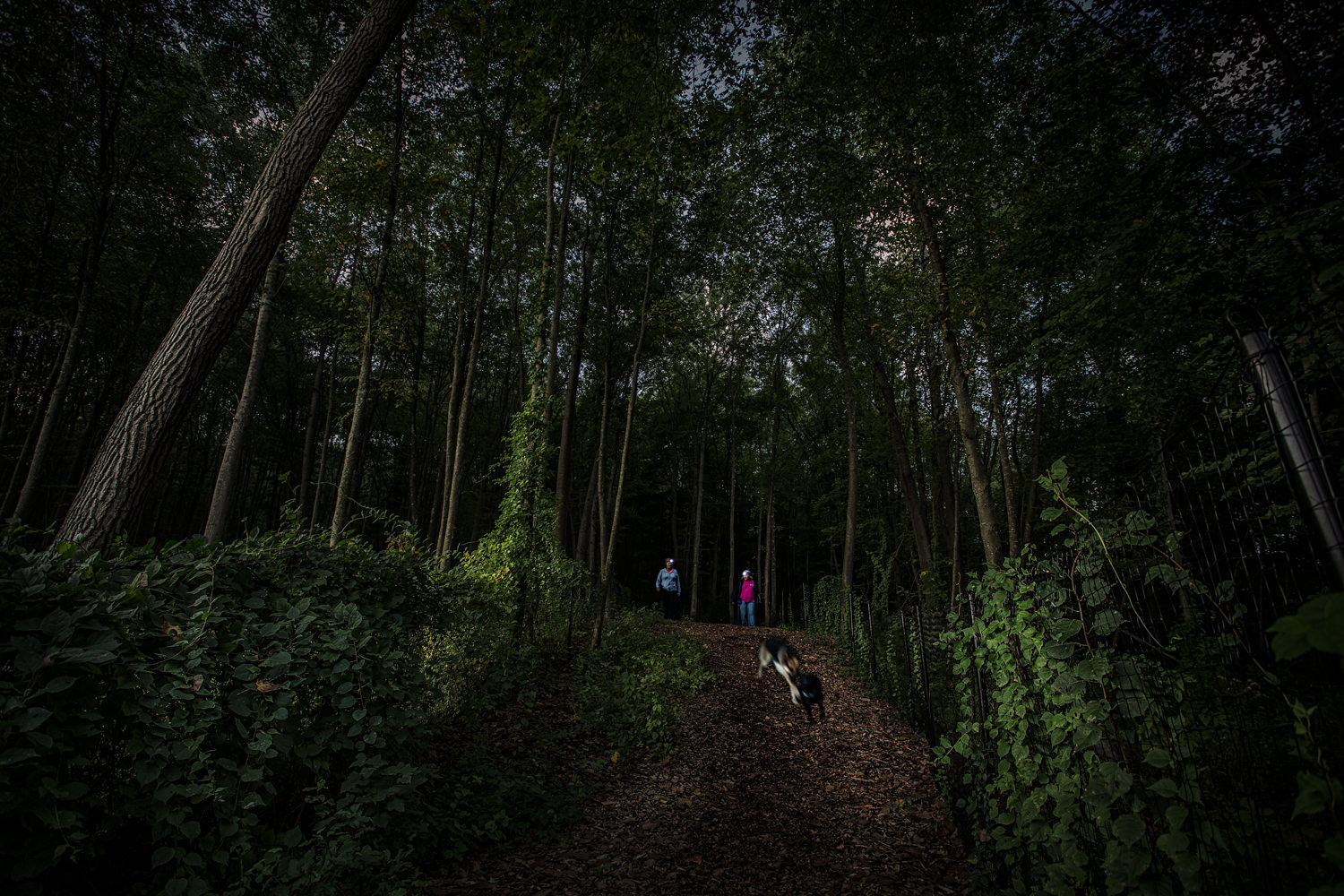
Regional Managers Maureen and Leslie emerge with headlamps from their early morning walk in the south woods. Pups Justine and Dane at full clip are just a blur. And together, it turns out, sound like a really big friggin’ bear, mountain lion…or maybe just a couple of enthusiastic puppies.
Equally prevalent in the early-morning quiet were the hiss and crackle of welders crafting the framework on Guiding Eyes’ CDC expansion project. The sound of progress. The renovation is ambitious, emblematic of Guiding Eyes’ leadership role in the global service dog community, and promises to propel the breeding kennel forward for another 60+ years. I can’t wait to return once it’s all done.
While construction is ongoing, breeding kennel operations have been transplanted into a couple temporary locations on campus. During my visit, all “little” pups were housed temporarily in a multi-function room called the “Big Room”. A flick of the light switch, the little furballs start to stir, and a morning routine of feeding and cleaning gets underway.
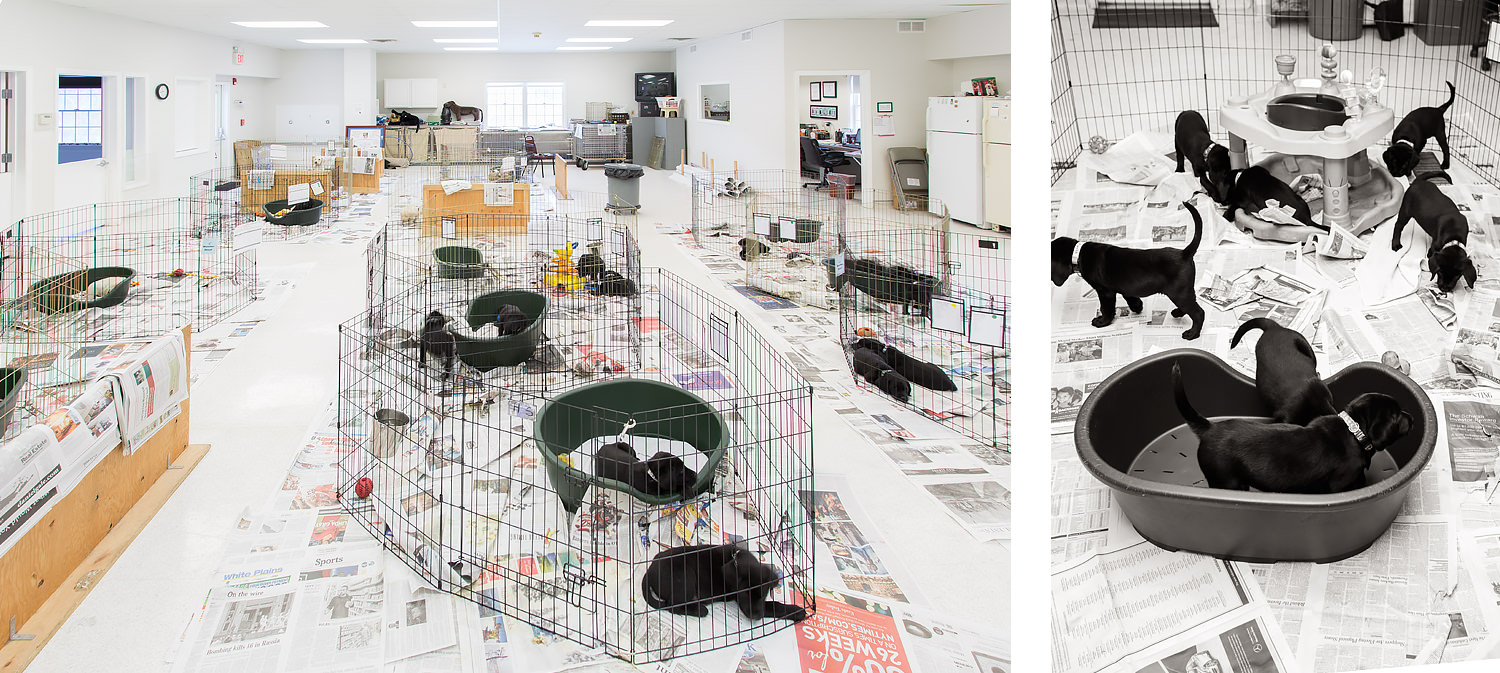
The “Big Room” is a large open space subdivided with oversize x-pens for pups to eat, sleep, and play in between outdoor playtime and socialization exercises.
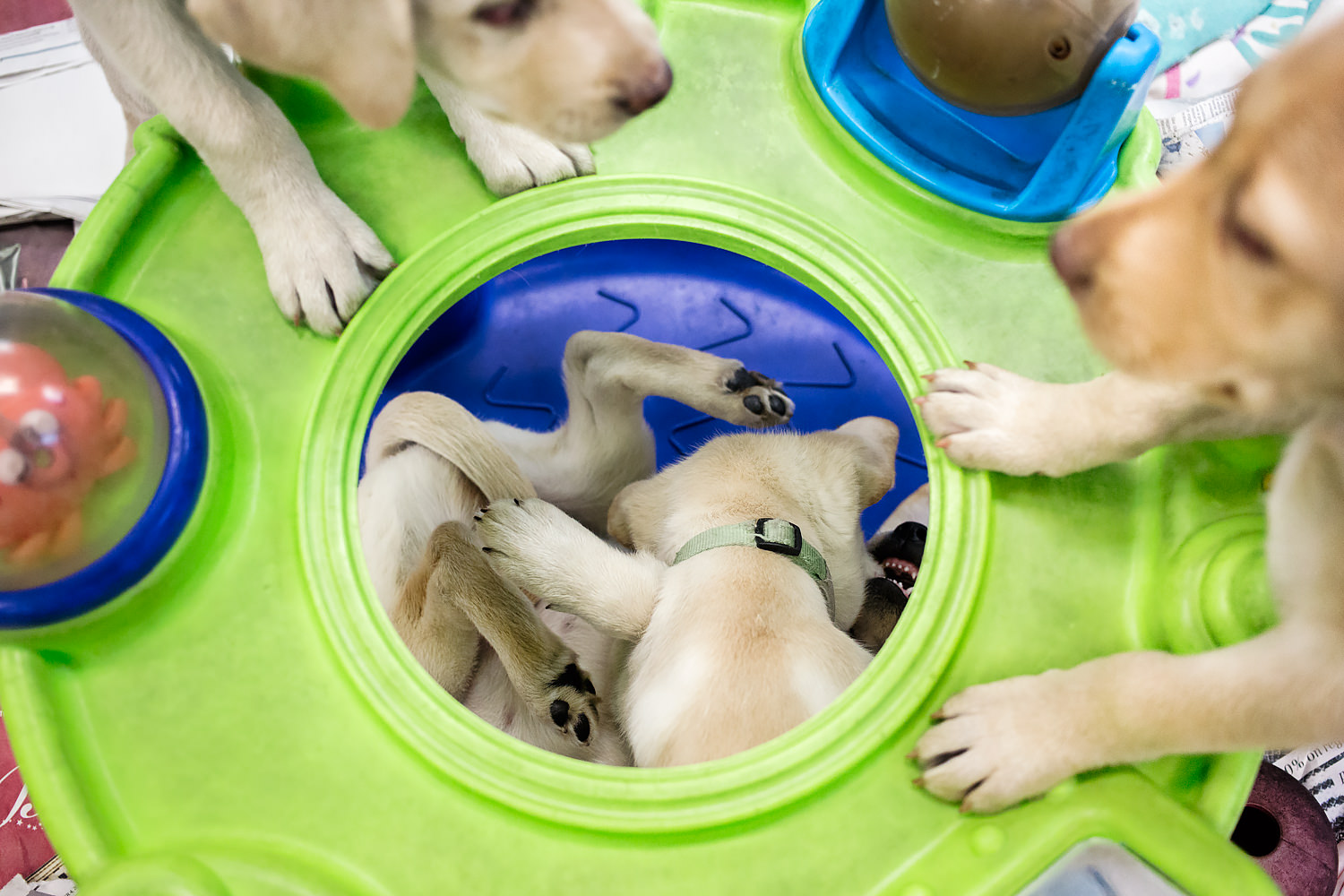
Once breakfast ends, the ruckus starts. They are toddlers after all. At times, it can be difficult to distinguish which pieces-parts go with which pups.
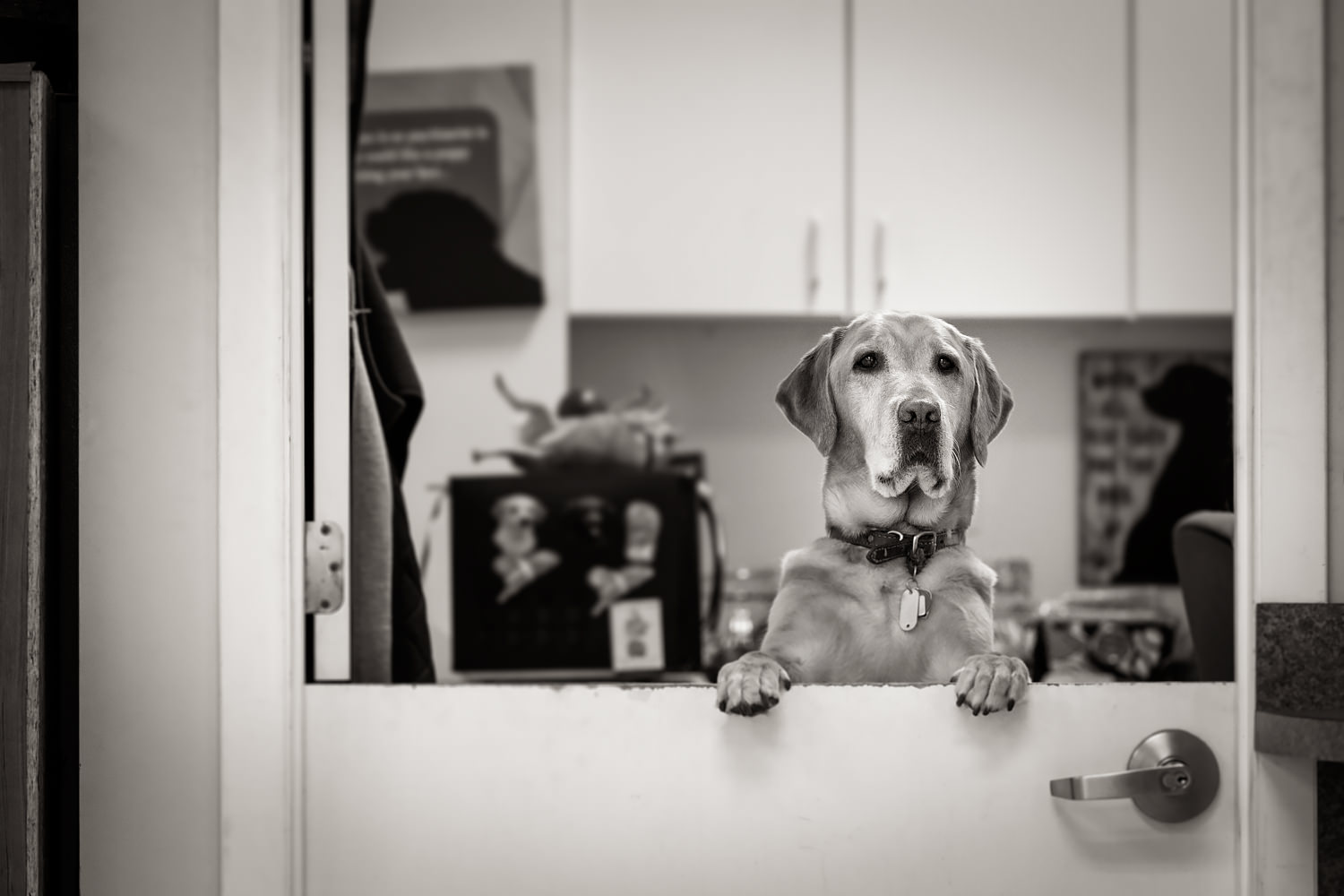
The late Whitman, Senior Executive Assistant and Chief of Big Room Security, kept a close eye on my comings and goings throughout the day. We came to an agreement; I got access in exchange for scratching under the ears. RIP Whitman.
In general, staffers were open but reticent to being photographed. As a family photographer, it’s quite common for people to be shy in front of the camera. But something was different on this project. The more time I spent on campus the more it became clear the reticence had little to do with shyness and everything to do with not wanting to be singled out. A pure form of dedication to team. All roles are essential, none more important than the next. Their openness to the camera’s intrusion was about pride in their work and passion for sharing the mission. Out of respect for the team, I photographed no staff individually other than when doing their normal daily work. With one exception, Breeding Kennel Manager Maria. If there is a matriarch at the CDC, it is Maria. The pups are like her kids, each as if it’s her first.
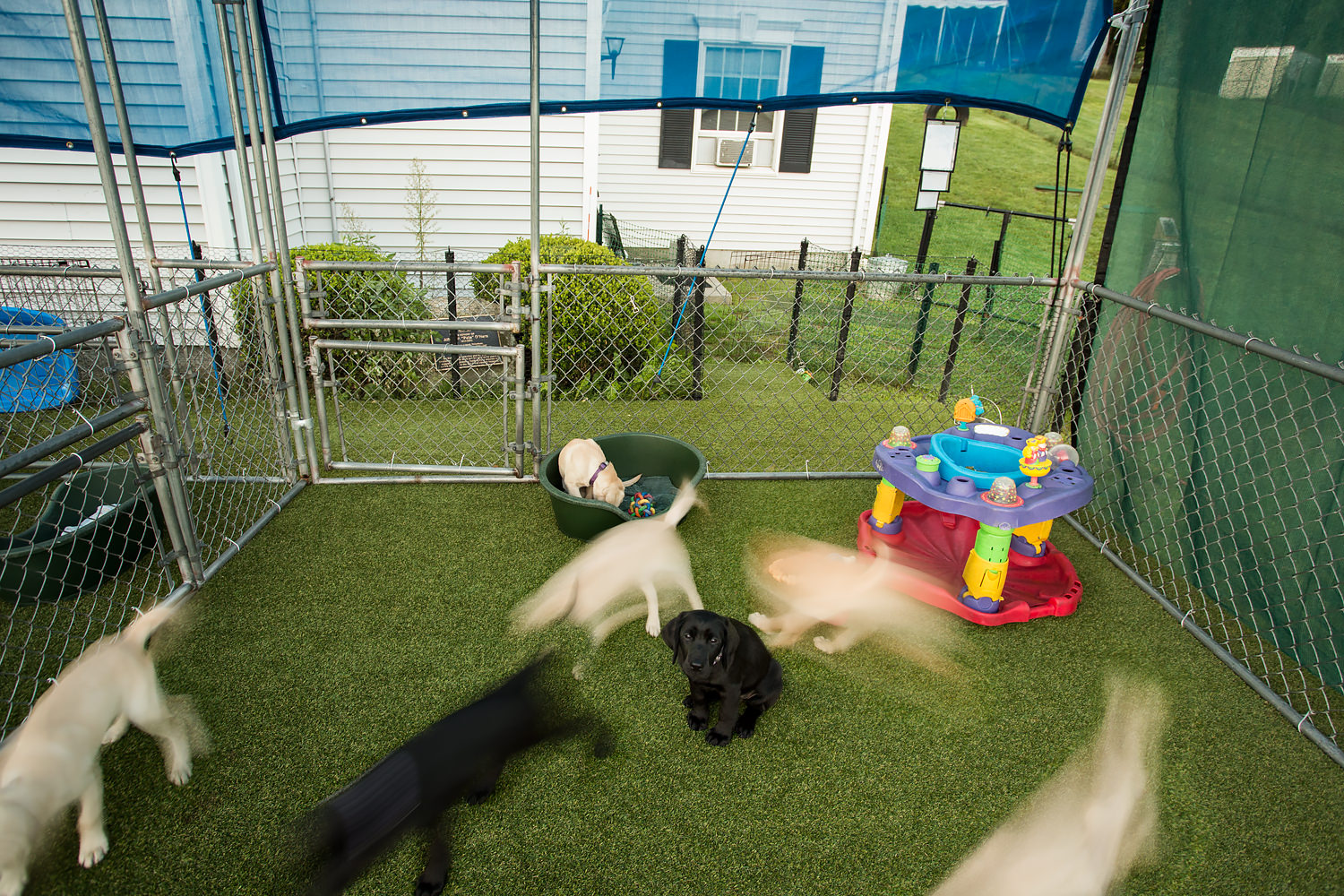
Full of energy from a good night’s rest, morning playtime is a flurry of activity for the “S” litter.
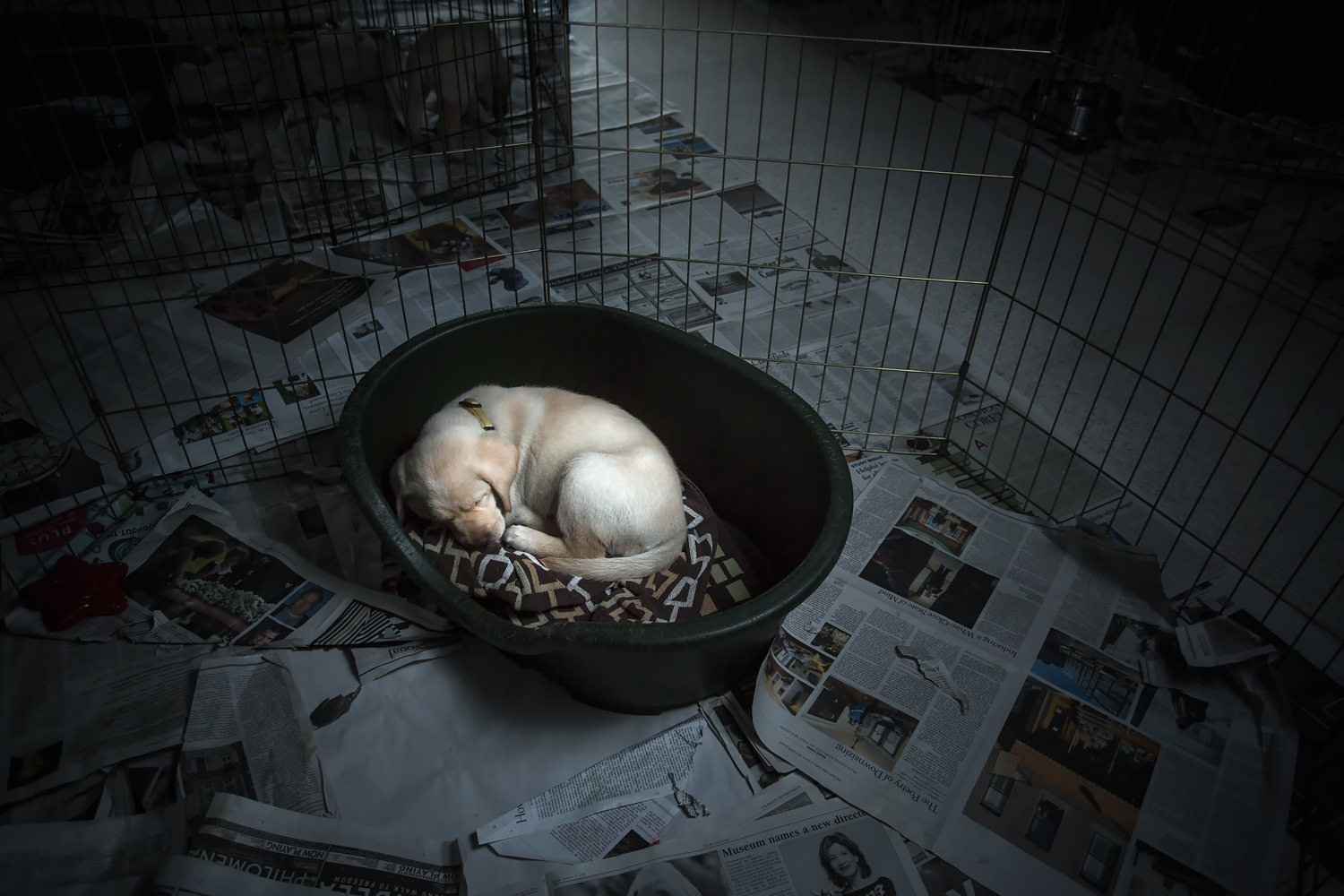
Still quite young, it doesn’t take much to tire the little ones out. With morning feedings, cleaning, and play done, it’s back inside for a nap. Lights out for Caitlyn.
Thirty or so yards outside the Big Room is the interim “Big Dog” kennel. The Big Dog kennel provides short-term housing for broods and studs on campus for breeding. Along with new arrivals from the puppy raising program, returning for breeder evaluation. Guiding Eyes holistic approach to health and wellness is especially evident with their older dogs. These dogs work hard, play hard, and take full advantage of the expansive outdoor space on their 30+ acre campus.
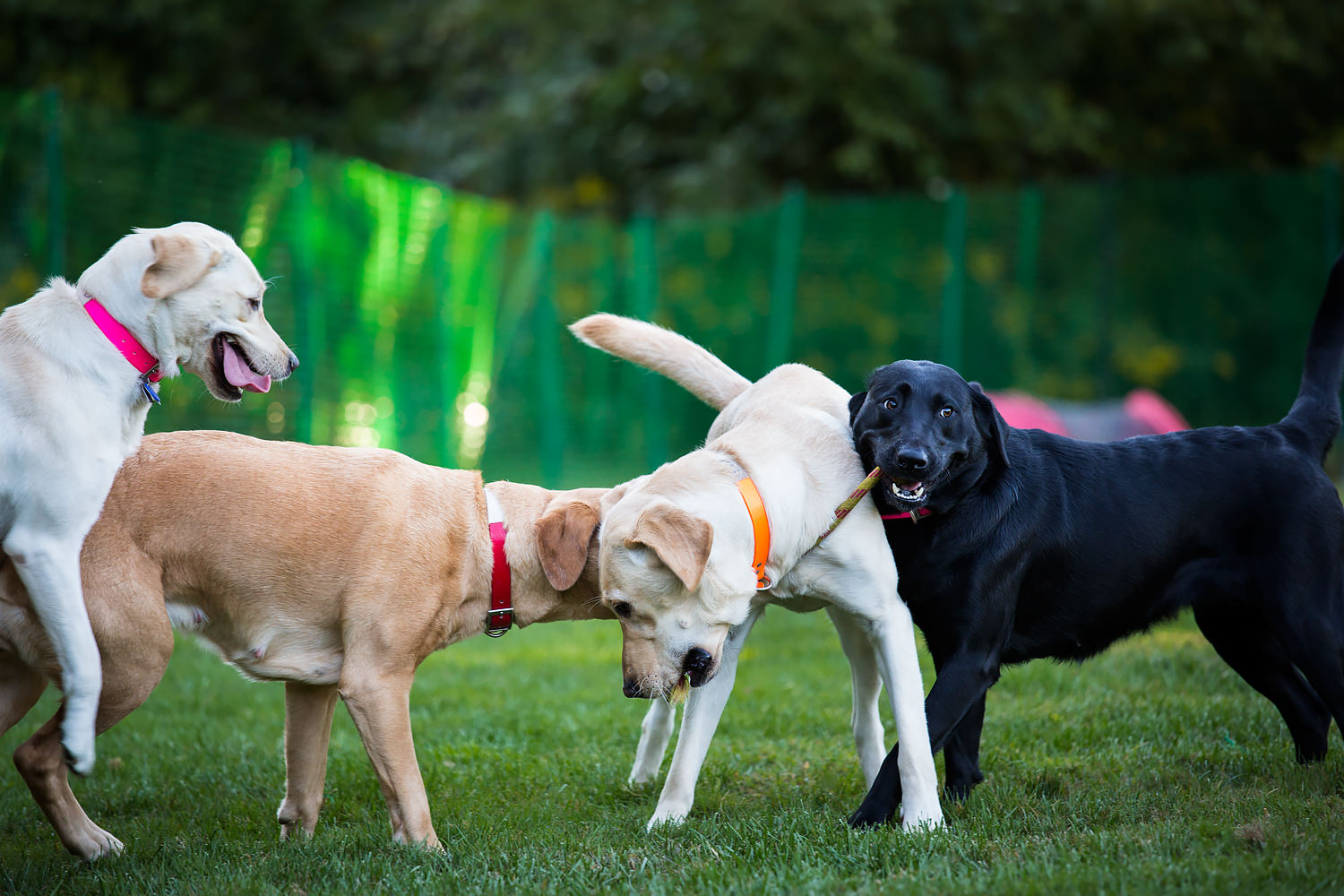
Play is polite for the most part. A skill honed during the puppy raising process. But occasionally gets frisky. They are on campus to breed after all.
Once morning chores are done, staff work with pups individually and in small groups on socialization. Socialization exercises are tailored both to assess suitability of pups for placement in the volunteer puppy raising program as well to ready those that do place for transition. Socialization outings include continued work on name recall, basic commands, exposure to various underfootings, as well as crating and body handling. All skills that help pups succeed no matter which path they choose – Guiding Eyes service dog or otherwise.

Brenda works with pup Ada on a body handling exercise called “hold & release”. Essentially a firm extended hug to gauge and improve each pups’ comfort level with being touched and constrained. Both important skills for guide work.
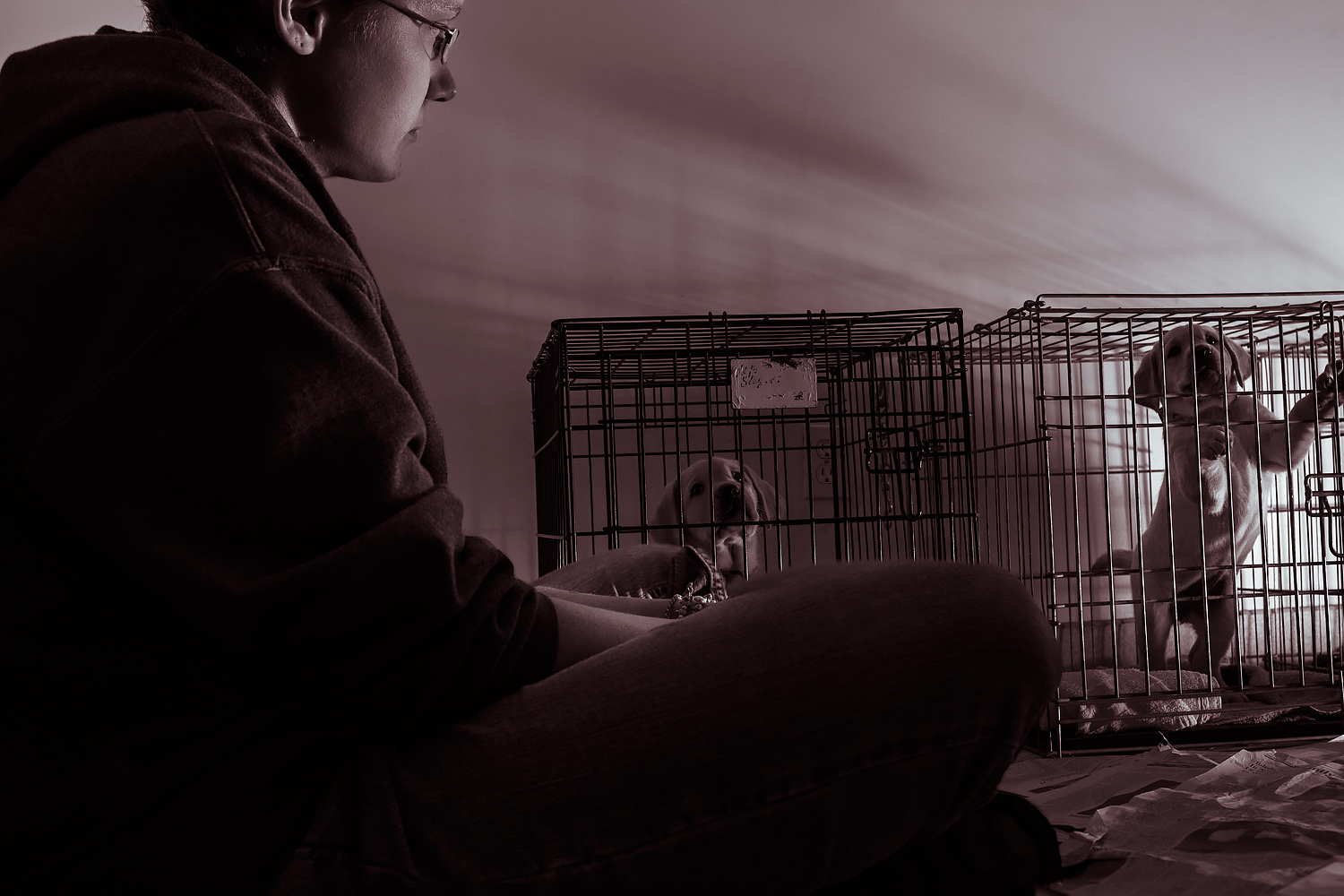
Pups Aron, Ada, and Andre work on crating – learning to settle quickly and to remain settled for extended periods of time. At this early stage, crating lasts only 10-15 minutes with Brenda sitting nearby to provide support in the form of a soothing voice, touch, or treat.
Throughout the day, dogs’ physical needs are tended do with quick checkups both in the Big Dog kennel and onsite veterinary hospital. Ears, teeth, gums, pads etc. are checked. They get weighed in, brushed, and have their nails clipped. Routine tasks thanks largely to all the body handling practice pups have had by this stage. I don’t recall vet visits with my dog growing up being quite so pleasant.
Next door to the vet hospital is the interim cryogenics and reproduction lab – hub for Guiding Eyes’ world renowned breeding program. Leveraging decades of health and temperament data collected on most Guiding Eyes dogs, sophisticated statistical analyses, and the genius of Jane Russenberger, Senior Director of Genetics and Breeding, and Clover Williams, Reproduction and Cryogenics Manager, Guiding Eyes breeds dogs as well suited to guide work as any in the world, with each generation better than the one before.
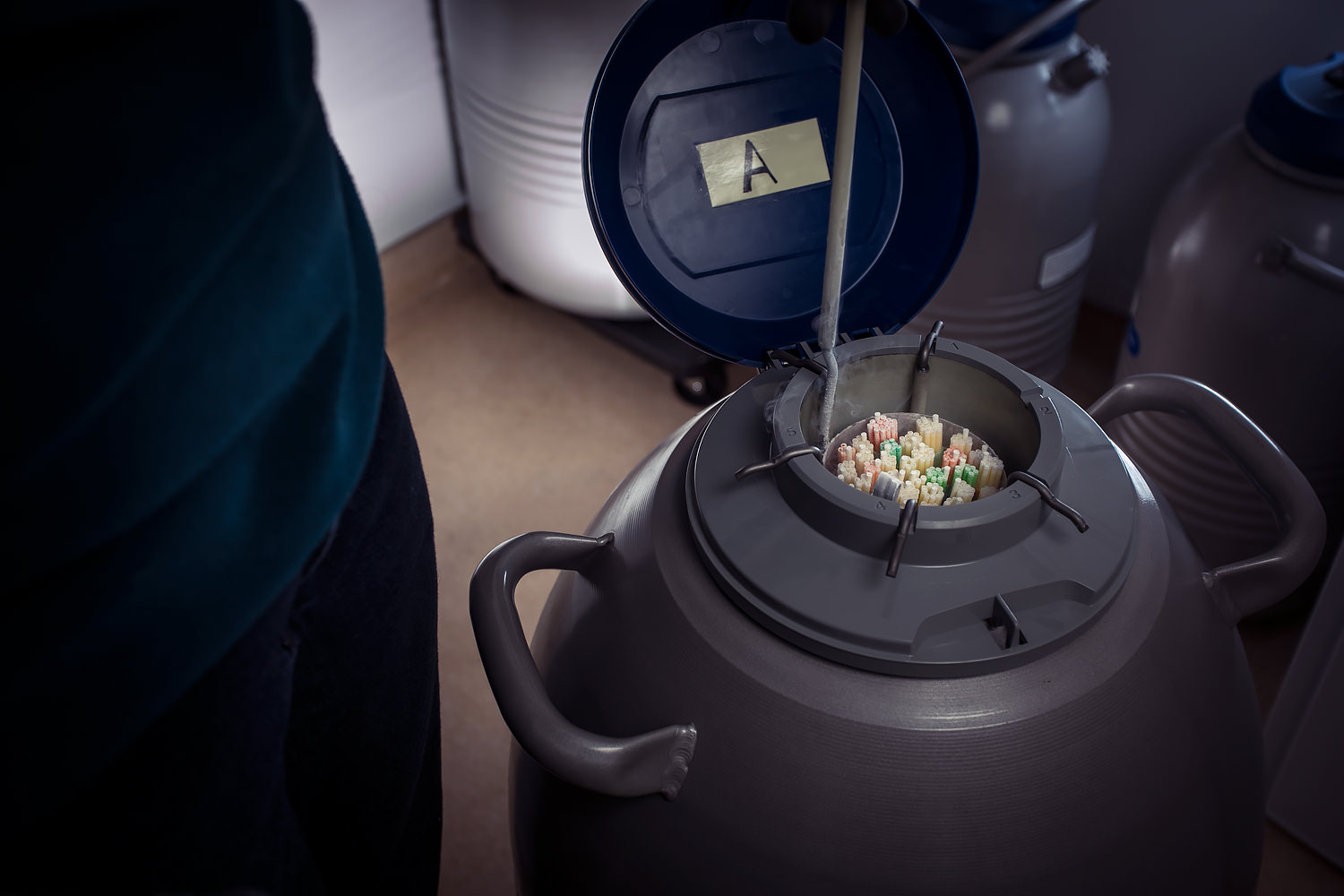
Preserved semen in freezing straws is stored in liquid nitrogen cryogenic tanks. Freezing semen allows Guiding Eyes to save semen from some males and still send them on to become working guides. It also enables sharing between guide schools to improve breeding colonies worldwide.
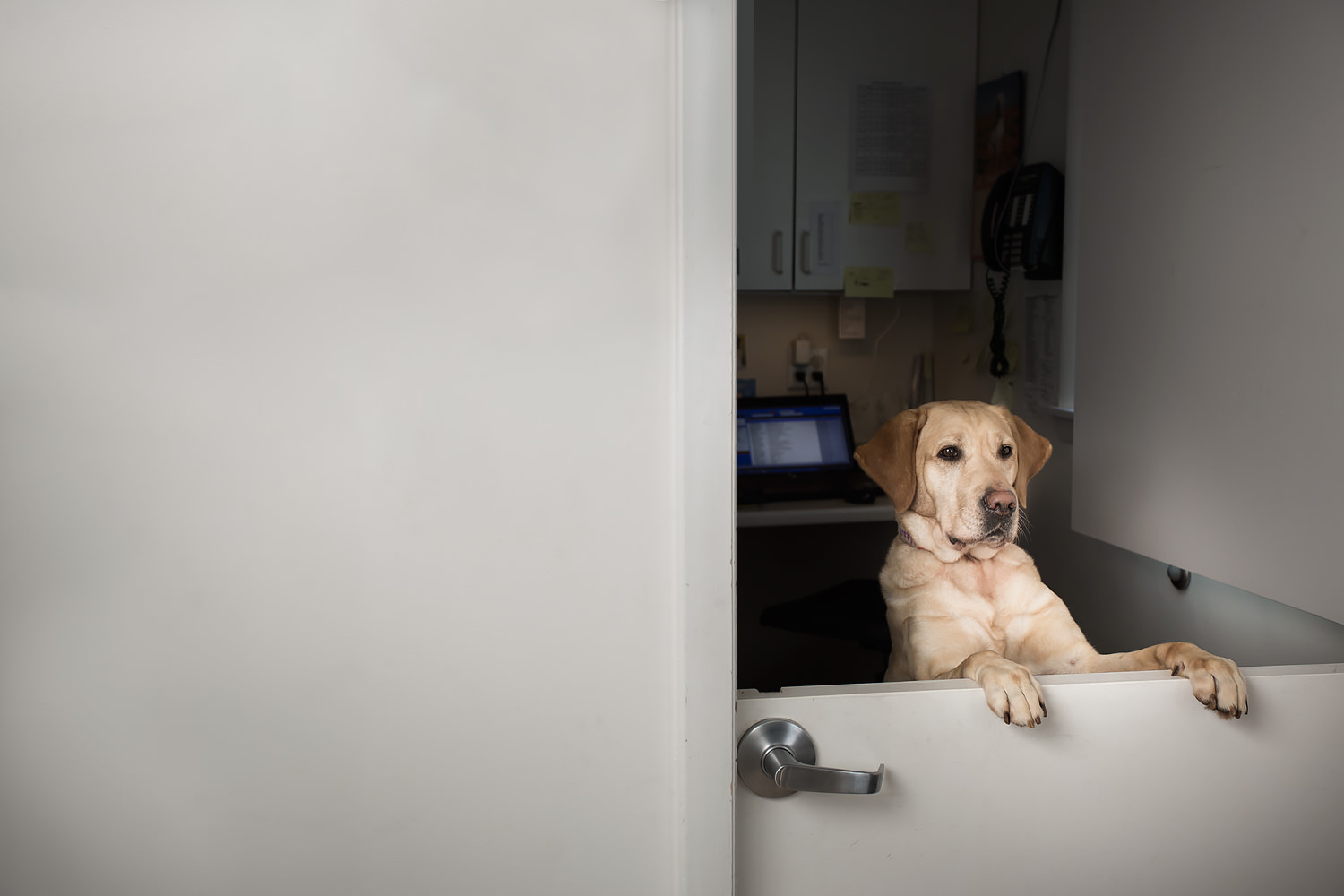
Guiding Eyes employs two types of breeding – natural and transcervical insemination. Brood Maura waits inside Clover’s office while semen is collected from a stud outside.
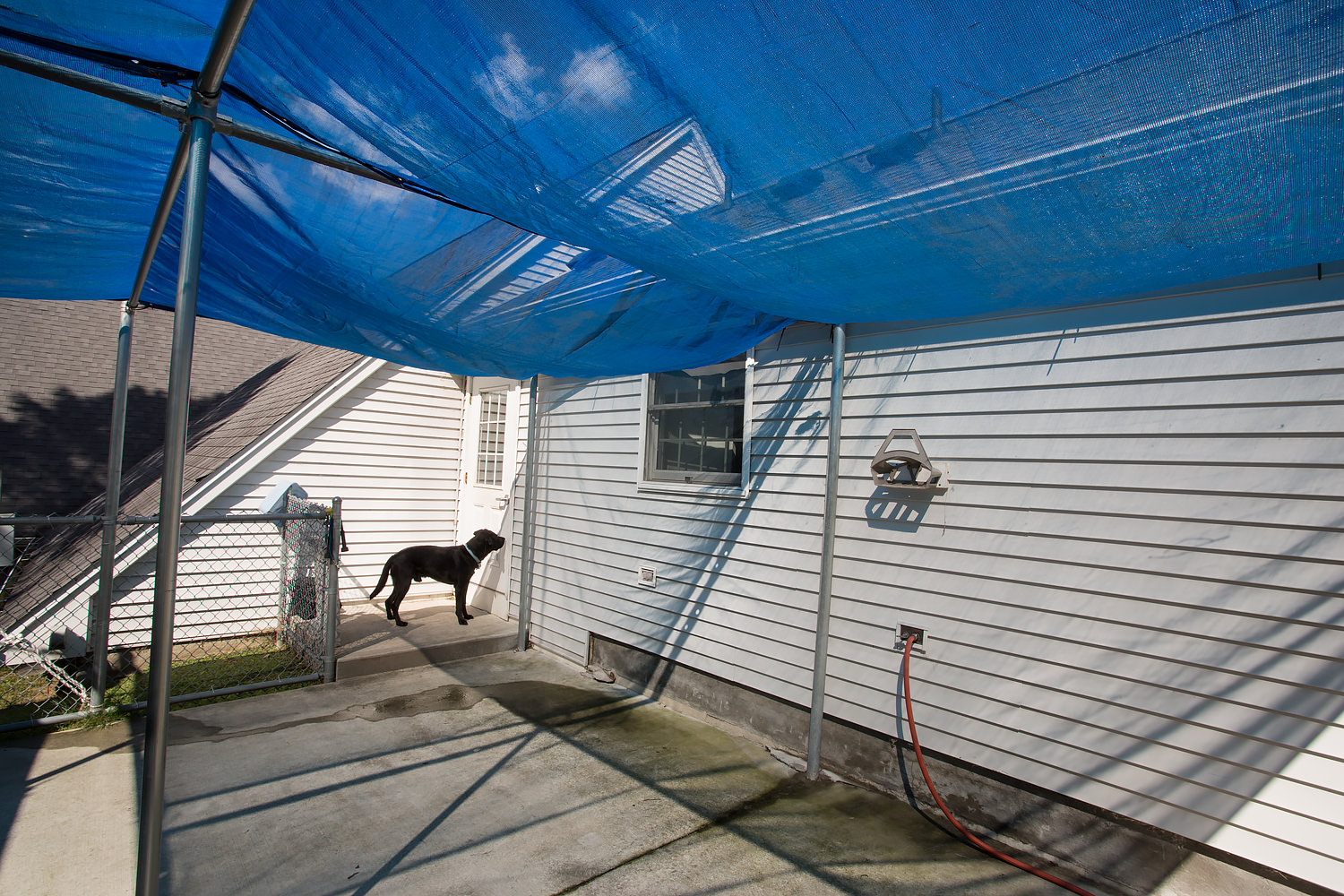
While construction continues on a new state-of-art cryo and reproduction lab, natural matings and semen collection take place in a pen located just outside the interim cryo lab. Affectionately known as the “honeymoon suite”. The brood is staged in a small holding area inside the lab while the stud is brought into the pen around back. Stud Cadet is keenly aware his date awaits on the opposite side of the door.
At 8 weeks of age, individual pups are evaluated in a formal temperament “Pup Test”. The Pup Test assesses energy level, reactions to noises and novel objects, dog distraction, adaptability, resilience, and willingness to work with people as indicators of which pups have the greatest potential to become guides. All tests are video recorded and scored as part of each pup’s lifetime record. Pups demonstrating the desired patterns of behavior are recommended for placement in the volunteer puppy raising program.
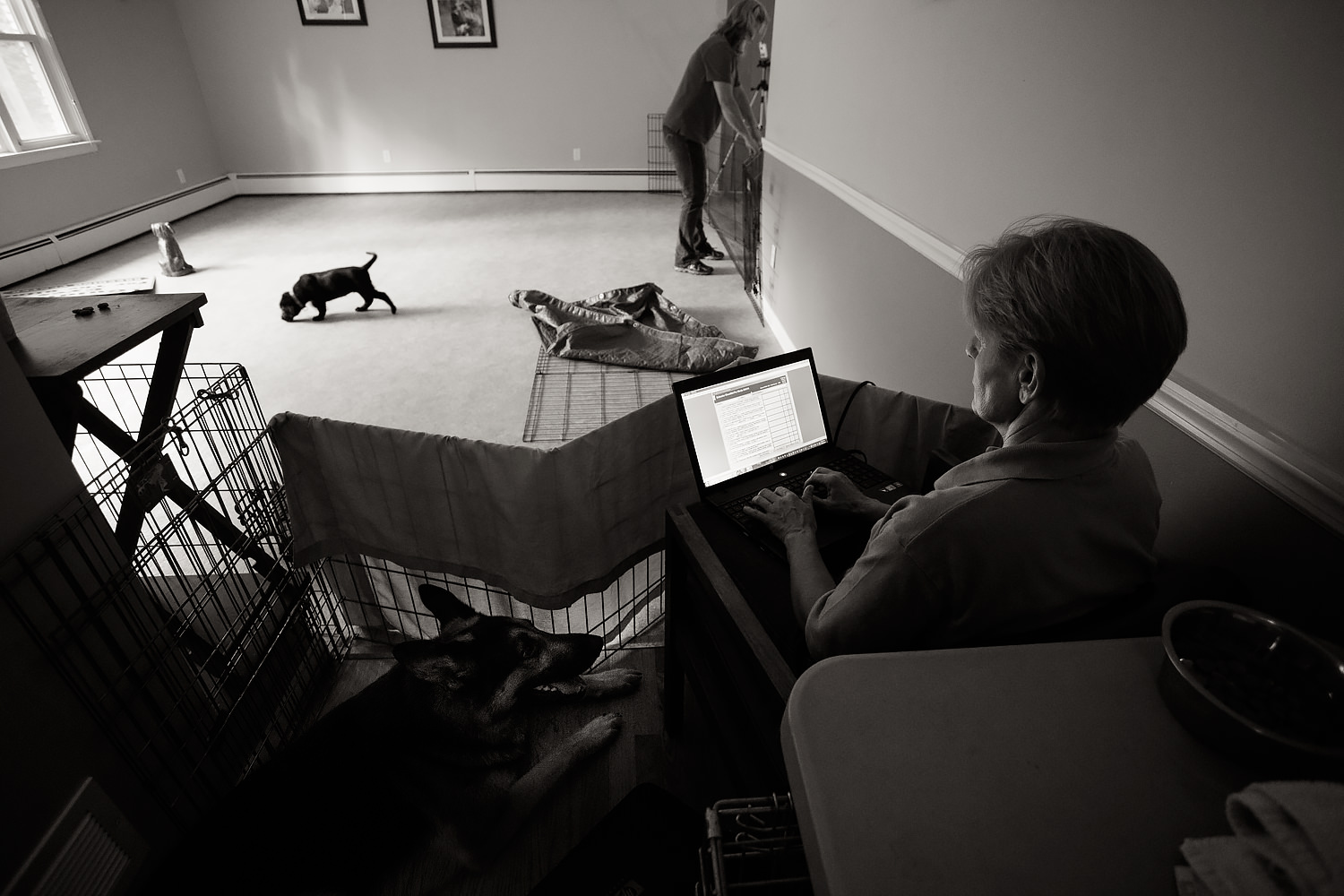
Program Manager of Canine Development, Helen, along with dog distraction for the day, retired stud Aldo, observe and score Aleda from the sidelines.
Back out to play as the day winds down.
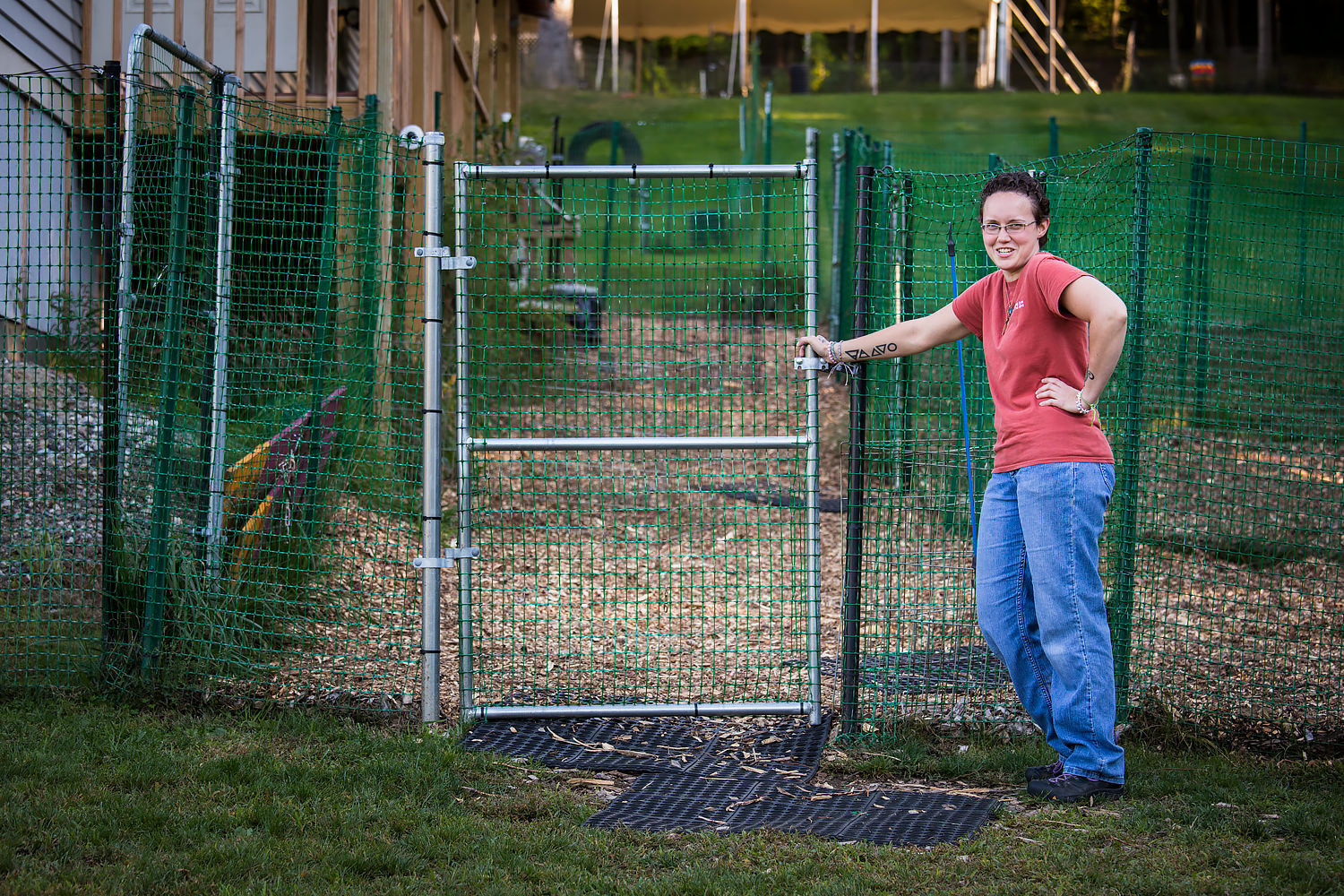
“Heya, Mr. Camera Guy, are you sure you want to sit there!?” Fair warning from Brenda before the chute is opened.
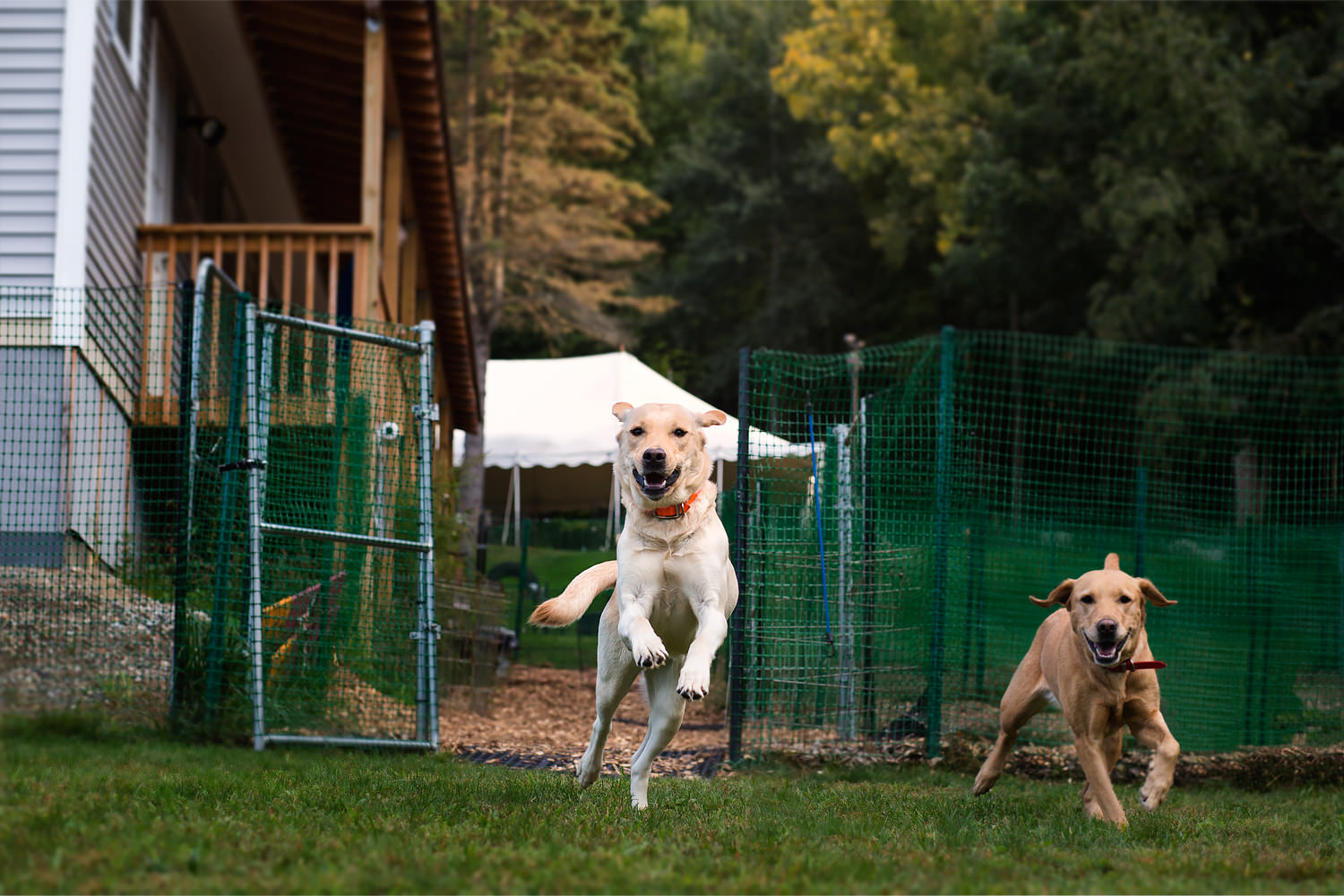
Out the chute! I’ve seen many a lab romping around backyards, but I’ve never seen dogs run so freely. It is stampede like in that you can hear and feel them through the ground. A byproduct of the large scale open space, their outstanding fitness and athleticism, and a prevailing pack play mentality. Everything, including play, is done in a higher gear at the CDC.
Set up in the hillside behind the CDC are acres of fenced in woods, glades, and meandering trails. We lucked out with a beautiful fall day to play. It is otherworldly – dark and dappled with light filtering through the canopy. The dogs in packs disappear, steering their way through trees with tails like rudders. You can hear but not see them. Then they reappear. Fused by a stick. Chasing. Stalking.
Once a month, in conjunction with graduation weekends, the CDC hosts tours for volunteer puppy raisers in town to see graduation. There is a shared passion and mutual respect between volunteers and staff which makes these visits a bit family reunion like. There is also no denying the piles of cute puppies help soften the blow of saying goodbye. And entice the notion of raising another. Which many do.
At around 8 weeks of age, pups are matched with volunteer raisers in one of 36 puppy raising regions. Sometimes raisers pick them up. Sometimes they hitch a ride with staff or volunteer drivers. Pups in the puppy raising program live with their volunteer raisers for ~14-16 months before returning to Guiding Eyes Training Center, which is where we’ll pick back up next post.
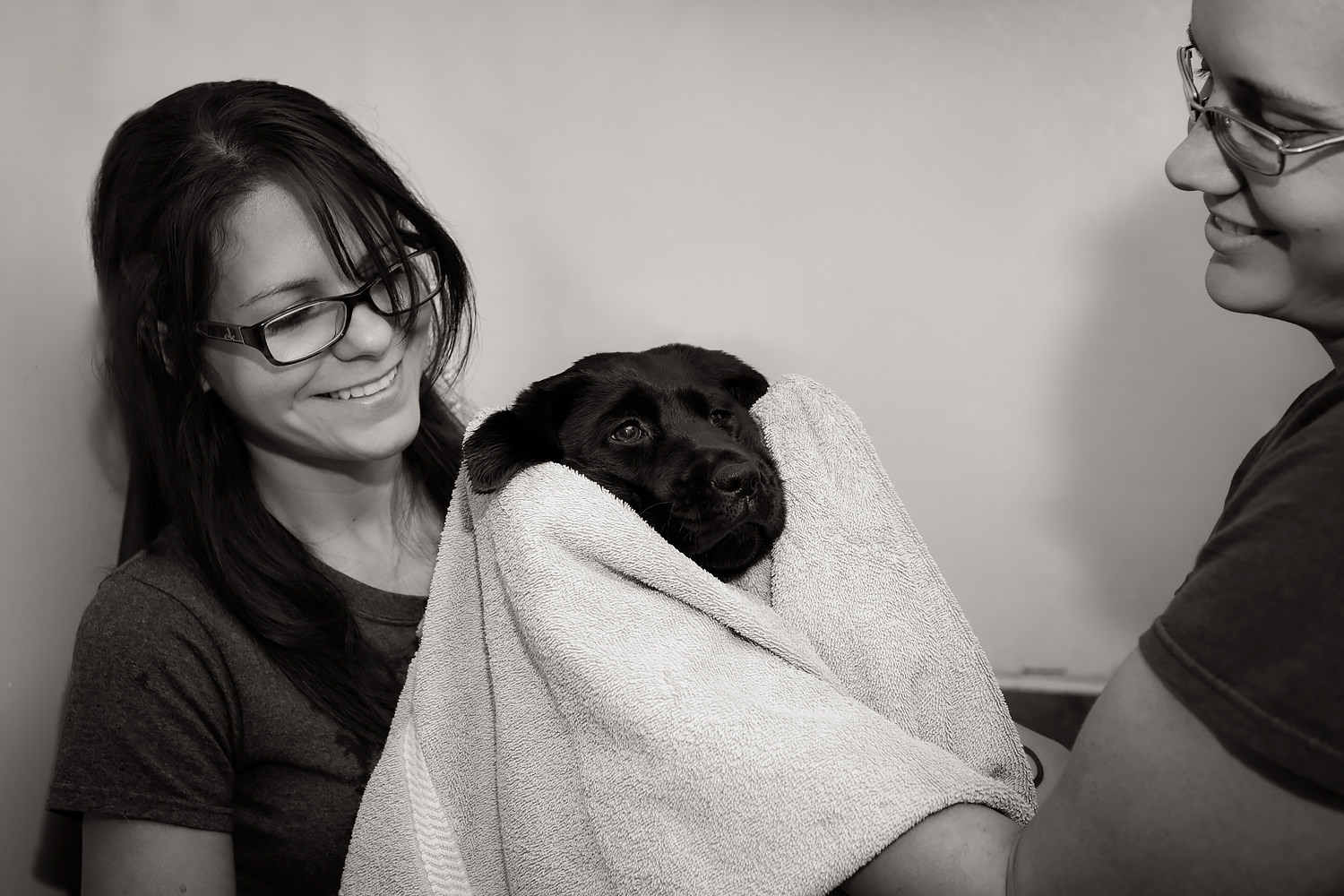
Toula was packed and headed out the door when kennel techs Frances and Brenda snatched her up for one last bath. A sneaky way to say their final goodbyes.
Next post we’ll pay a visit to Guiding Eyes’ Training Center in Yorktown Heights. If you have not already, you can sign up for notification when future posts in this series go live. Just enter your info below.
Special thanks to Photography Concentrate for their support in making this project happen.
You can support Guiding Eyes and the Canine Development Center by sharing this post or making a donation to the One Step Ahead campaign.
